Management Accounting: Systems, Benefits, and Reporting
VerifiedAdded on 2023/01/17
|23
|5558
|41
AI Summary
This document provides an overview of management accounting systems, their benefits, and methods used for managerial reporting. It also explains the computation of net profit using absorption and marginal costing.
Contribute Materials
Your contribution can guide someone’s learning journey. Share your
documents today.
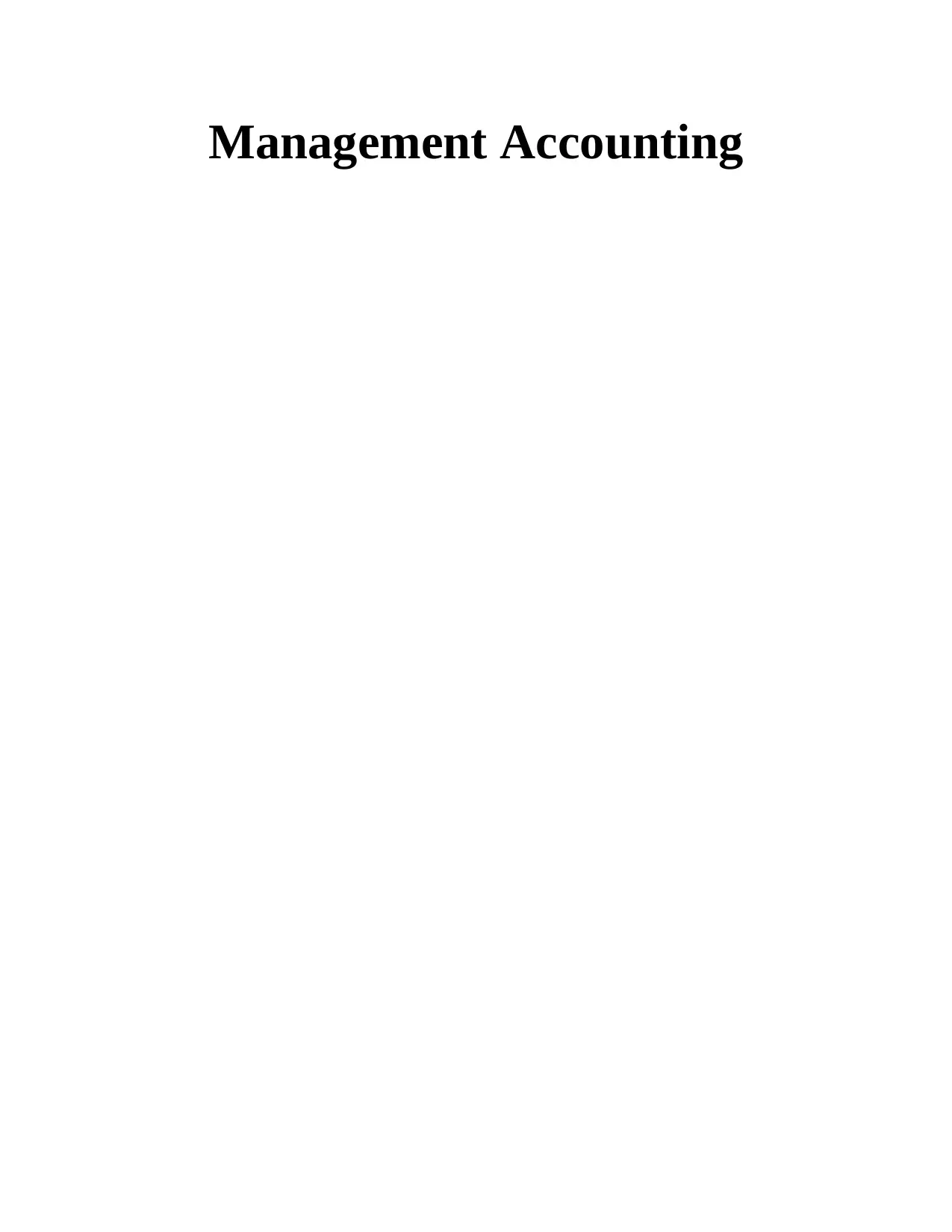
Management Accounting
Secure Best Marks with AI Grader
Need help grading? Try our AI Grader for instant feedback on your assignments.

TABLE OF CONTENTS
INTRODUCTION...........................................................................................................................3
LO1..................................................................................................................................................3
Explaining management accounting systems along with its benefits of different systems.........3
Presenting methods used for managerial reporting aspects.........................................................4
Critically evaluating how management accounting systems and reporting is integrated within
organizational process.................................................................................................................5
LO2..................................................................................................................................................6
Computation of net profit by employing absorption and marginal costing.................................6
LO3..................................................................................................................................................9
Explaining the advantages and disadvantages of different planning tools used in budgetary
control..........................................................................................................................................9
Analyzing the usage and application of different planning tools used in budgetary control....11
Exhibits the manner in which financial problems can be responded.........................................14
CONCLUSION..............................................................................................................................16
REFERENCES..............................................................................................................................18
INTRODUCTION...........................................................................................................................3
LO1..................................................................................................................................................3
Explaining management accounting systems along with its benefits of different systems.........3
Presenting methods used for managerial reporting aspects.........................................................4
Critically evaluating how management accounting systems and reporting is integrated within
organizational process.................................................................................................................5
LO2..................................................................................................................................................6
Computation of net profit by employing absorption and marginal costing.................................6
LO3..................................................................................................................................................9
Explaining the advantages and disadvantages of different planning tools used in budgetary
control..........................................................................................................................................9
Analyzing the usage and application of different planning tools used in budgetary control....11
Exhibits the manner in which financial problems can be responded.........................................14
CONCLUSION..............................................................................................................................16
REFERENCES..............................................................................................................................18
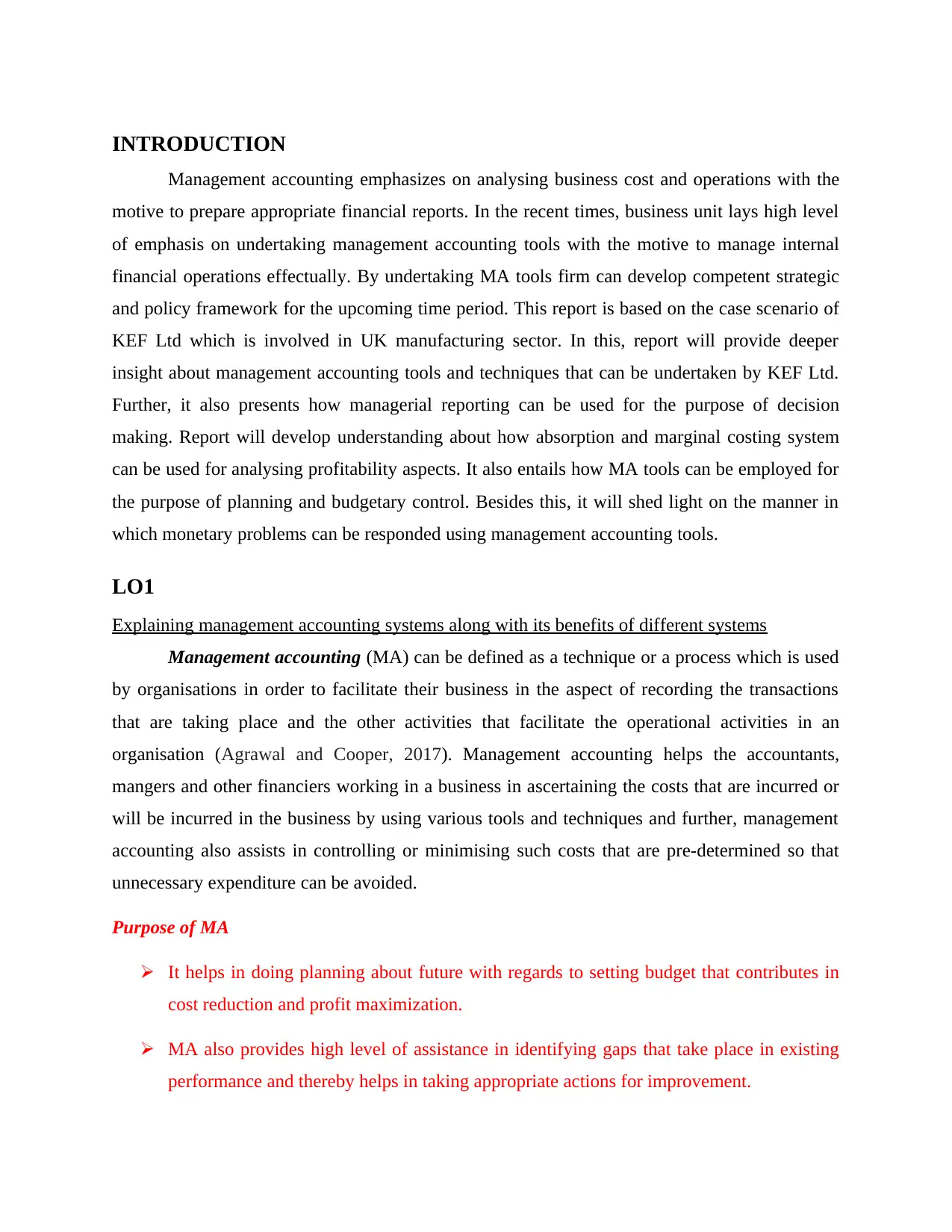
INTRODUCTION
Management accounting emphasizes on analysing business cost and operations with the
motive to prepare appropriate financial reports. In the recent times, business unit lays high level
of emphasis on undertaking management accounting tools with the motive to manage internal
financial operations effectually. By undertaking MA tools firm can develop competent strategic
and policy framework for the upcoming time period. This report is based on the case scenario of
KEF Ltd which is involved in UK manufacturing sector. In this, report will provide deeper
insight about management accounting tools and techniques that can be undertaken by KEF Ltd.
Further, it also presents how managerial reporting can be used for the purpose of decision
making. Report will develop understanding about how absorption and marginal costing system
can be used for analysing profitability aspects. It also entails how MA tools can be employed for
the purpose of planning and budgetary control. Besides this, it will shed light on the manner in
which monetary problems can be responded using management accounting tools.
LO1
Explaining management accounting systems along with its benefits of different systems
Management accounting (MA) can be defined as a technique or a process which is used
by organisations in order to facilitate their business in the aspect of recording the transactions
that are taking place and the other activities that facilitate the operational activities in an
organisation (Agrawal and Cooper, 2017). Management accounting helps the accountants,
mangers and other financiers working in a business in ascertaining the costs that are incurred or
will be incurred in the business by using various tools and techniques and further, management
accounting also assists in controlling or minimising such costs that are pre-determined so that
unnecessary expenditure can be avoided.
Purpose of MA
It helps in doing planning about future with regards to setting budget that contributes in
cost reduction and profit maximization.
MA also provides high level of assistance in identifying gaps that take place in existing
performance and thereby helps in taking appropriate actions for improvement.
Management accounting emphasizes on analysing business cost and operations with the
motive to prepare appropriate financial reports. In the recent times, business unit lays high level
of emphasis on undertaking management accounting tools with the motive to manage internal
financial operations effectually. By undertaking MA tools firm can develop competent strategic
and policy framework for the upcoming time period. This report is based on the case scenario of
KEF Ltd which is involved in UK manufacturing sector. In this, report will provide deeper
insight about management accounting tools and techniques that can be undertaken by KEF Ltd.
Further, it also presents how managerial reporting can be used for the purpose of decision
making. Report will develop understanding about how absorption and marginal costing system
can be used for analysing profitability aspects. It also entails how MA tools can be employed for
the purpose of planning and budgetary control. Besides this, it will shed light on the manner in
which monetary problems can be responded using management accounting tools.
LO1
Explaining management accounting systems along with its benefits of different systems
Management accounting (MA) can be defined as a technique or a process which is used
by organisations in order to facilitate their business in the aspect of recording the transactions
that are taking place and the other activities that facilitate the operational activities in an
organisation (Agrawal and Cooper, 2017). Management accounting helps the accountants,
mangers and other financiers working in a business in ascertaining the costs that are incurred or
will be incurred in the business by using various tools and techniques and further, management
accounting also assists in controlling or minimising such costs that are pre-determined so that
unnecessary expenditure can be avoided.
Purpose of MA
It helps in doing planning about future with regards to setting budget that contributes in
cost reduction and profit maximization.
MA also provides high level of assistance in identifying gaps that take place in existing
performance and thereby helps in taking appropriate actions for improvement.
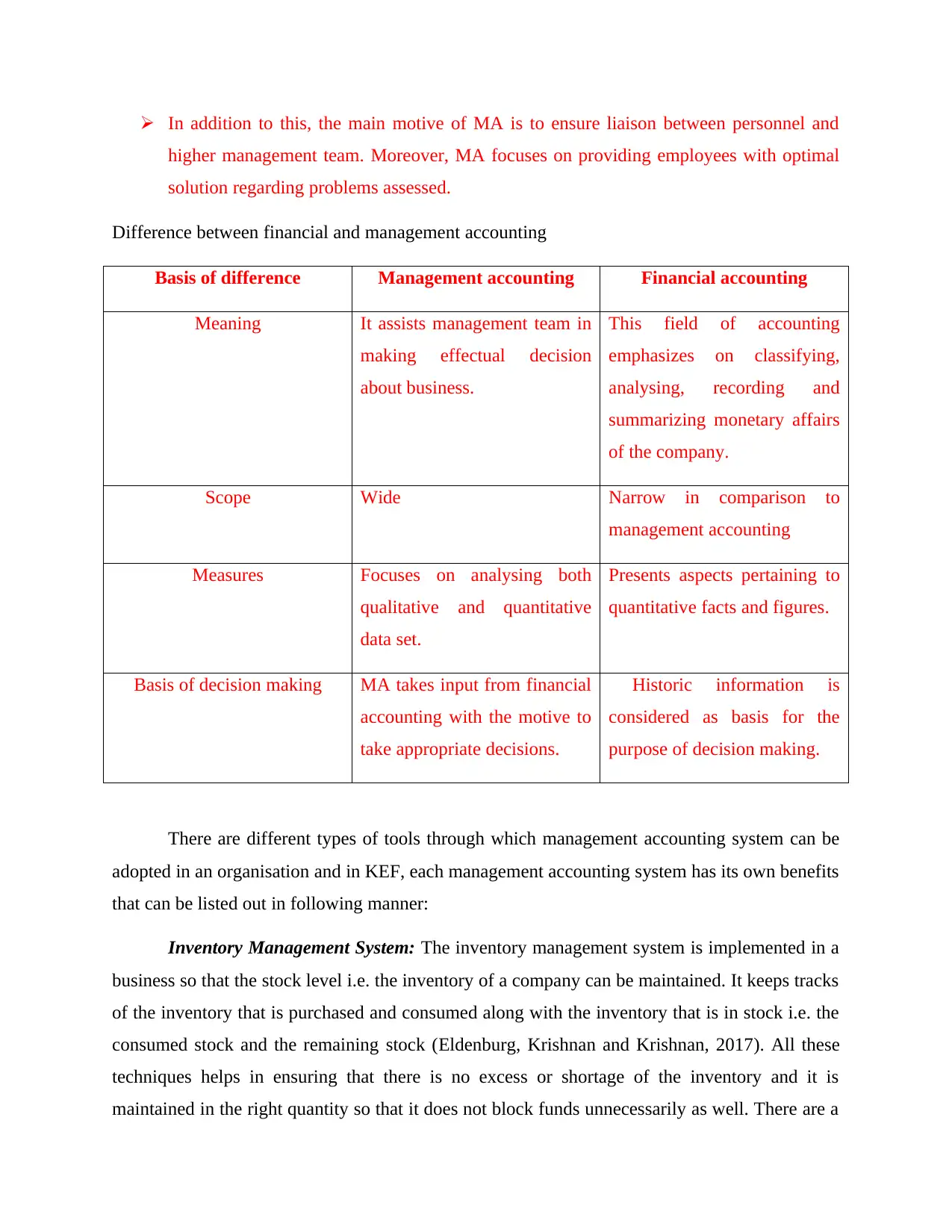
In addition to this, the main motive of MA is to ensure liaison between personnel and
higher management team. Moreover, MA focuses on providing employees with optimal
solution regarding problems assessed.
Difference between financial and management accounting
Basis of difference Management accounting Financial accounting
Meaning It assists management team in
making effectual decision
about business.
This field of accounting
emphasizes on classifying,
analysing, recording and
summarizing monetary affairs
of the company.
Scope Wide Narrow in comparison to
management accounting
Measures Focuses on analysing both
qualitative and quantitative
data set.
Presents aspects pertaining to
quantitative facts and figures.
Basis of decision making MA takes input from financial
accounting with the motive to
take appropriate decisions.
Historic information is
considered as basis for the
purpose of decision making.
There are different types of tools through which management accounting system can be
adopted in an organisation and in KEF, each management accounting system has its own benefits
that can be listed out in following manner:
Inventory Management System: The inventory management system is implemented in a
business so that the stock level i.e. the inventory of a company can be maintained. It keeps tracks
of the inventory that is purchased and consumed along with the inventory that is in stock i.e. the
consumed stock and the remaining stock (Eldenburg, Krishnan and Krishnan, 2017). All these
techniques helps in ensuring that there is no excess or shortage of the inventory and it is
maintained in the right quantity so that it does not block funds unnecessarily as well. There are a
higher management team. Moreover, MA focuses on providing employees with optimal
solution regarding problems assessed.
Difference between financial and management accounting
Basis of difference Management accounting Financial accounting
Meaning It assists management team in
making effectual decision
about business.
This field of accounting
emphasizes on classifying,
analysing, recording and
summarizing monetary affairs
of the company.
Scope Wide Narrow in comparison to
management accounting
Measures Focuses on analysing both
qualitative and quantitative
data set.
Presents aspects pertaining to
quantitative facts and figures.
Basis of decision making MA takes input from financial
accounting with the motive to
take appropriate decisions.
Historic information is
considered as basis for the
purpose of decision making.
There are different types of tools through which management accounting system can be
adopted in an organisation and in KEF, each management accounting system has its own benefits
that can be listed out in following manner:
Inventory Management System: The inventory management system is implemented in a
business so that the stock level i.e. the inventory of a company can be maintained. It keeps tracks
of the inventory that is purchased and consumed along with the inventory that is in stock i.e. the
consumed stock and the remaining stock (Eldenburg, Krishnan and Krishnan, 2017). All these
techniques helps in ensuring that there is no excess or shortage of the inventory and it is
maintained in the right quantity so that it does not block funds unnecessarily as well. There are a
Secure Best Marks with AI Grader
Need help grading? Try our AI Grader for instant feedback on your assignments.

variety of techniques that can be used such as FIFO (First In First Out), LIFO (Last In First Out),
EOQ (Economic Order quantity) etc. LIFO deals with the earliest of consumption of the latest
stock that is in the warehouse and FIFO uses the older stock first and then the latest one. EOQ on
the other hand deduces a reorder level or point at which a particular quantity of goods should be
reordered so that the production of the company can keep running. For KEF, the best strategy
would be EOQ method since it ensures that the funds i.e. the working capital of the company
does not gets blocked unnecessarily and the stock is made available at all times.
Advantages Disadvantages
Ensures uninterrupted production
activities
It also helps in reducing storage as well
as ordering cost and thereby increases
profitability
For dealing with inventory
management systems business unit
needs to conduct training session. This
in turn imposes cost in front of the
company.
Time consuming process
Cost Accounting System: This technique of cost management helps the management in
ascertaining the cost that will be incurred on order to manufacture a particular product and also
determines whether it will be profitable or not to manufacture this product (Lopez-Valeiras,
Gomez-Conde and Naranjo-Gil, 2015).
Advantages Disadvantages
Helps in avoiding wastage, losses and
inefficiencies
Assists in identifying reason related to
profit or loss generated
Ensures cost reduction and profit
maximization
This accounting system leads problem
related to under or over absorption
Time consuming exercise as it requires
maintenance of many costing records
EOQ (Economic Order quantity) etc. LIFO deals with the earliest of consumption of the latest
stock that is in the warehouse and FIFO uses the older stock first and then the latest one. EOQ on
the other hand deduces a reorder level or point at which a particular quantity of goods should be
reordered so that the production of the company can keep running. For KEF, the best strategy
would be EOQ method since it ensures that the funds i.e. the working capital of the company
does not gets blocked unnecessarily and the stock is made available at all times.
Advantages Disadvantages
Ensures uninterrupted production
activities
It also helps in reducing storage as well
as ordering cost and thereby increases
profitability
For dealing with inventory
management systems business unit
needs to conduct training session. This
in turn imposes cost in front of the
company.
Time consuming process
Cost Accounting System: This technique of cost management helps the management in
ascertaining the cost that will be incurred on order to manufacture a particular product and also
determines whether it will be profitable or not to manufacture this product (Lopez-Valeiras,
Gomez-Conde and Naranjo-Gil, 2015).
Advantages Disadvantages
Helps in avoiding wastage, losses and
inefficiencies
Assists in identifying reason related to
profit or loss generated
Ensures cost reduction and profit
maximization
This accounting system leads problem
related to under or over absorption
Time consuming exercise as it requires
maintenance of many costing records
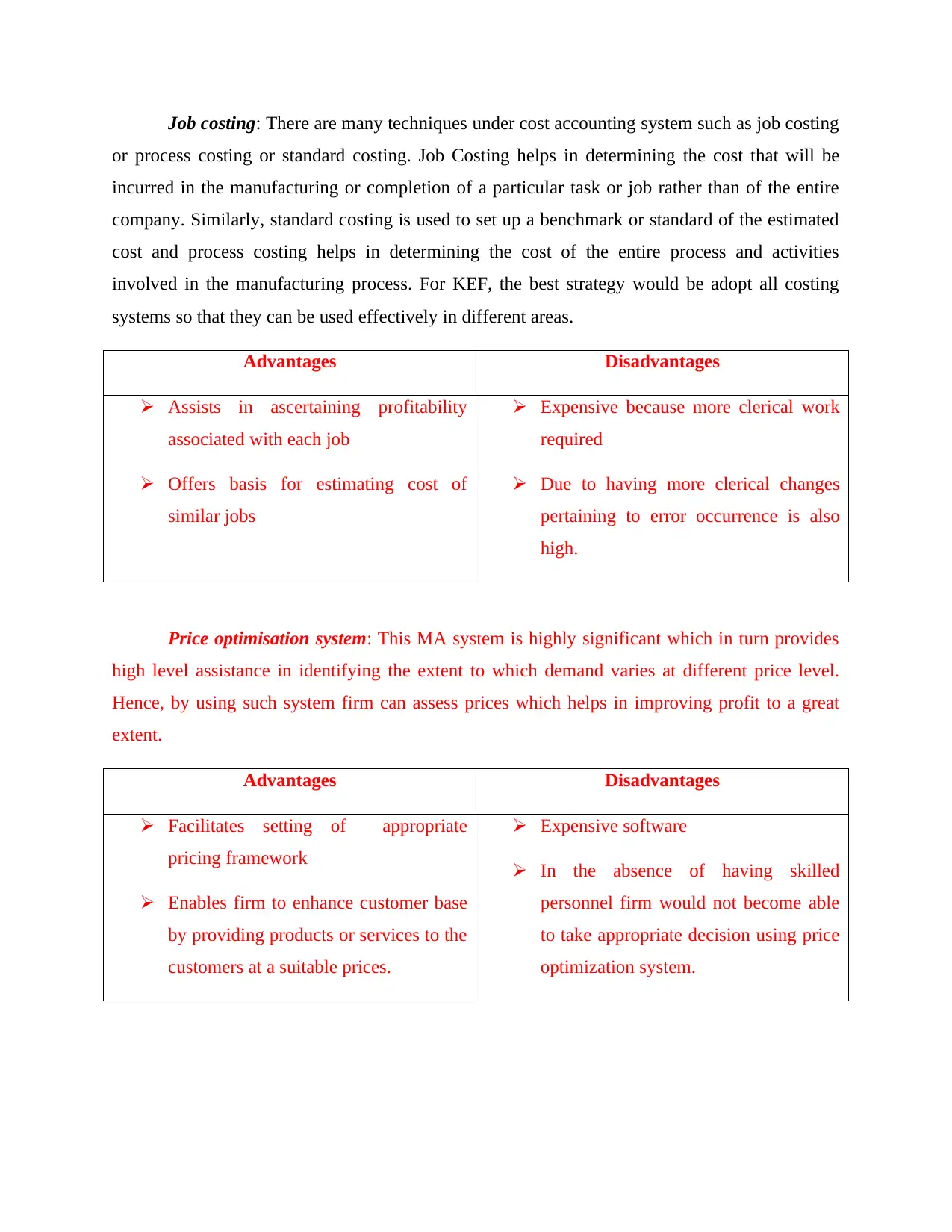
Job costing: There are many techniques under cost accounting system such as job costing
or process costing or standard costing. Job Costing helps in determining the cost that will be
incurred in the manufacturing or completion of a particular task or job rather than of the entire
company. Similarly, standard costing is used to set up a benchmark or standard of the estimated
cost and process costing helps in determining the cost of the entire process and activities
involved in the manufacturing process. For KEF, the best strategy would be adopt all costing
systems so that they can be used effectively in different areas.
Advantages Disadvantages
Assists in ascertaining profitability
associated with each job
Offers basis for estimating cost of
similar jobs
Expensive because more clerical work
required
Due to having more clerical changes
pertaining to error occurrence is also
high.
Price optimisation system: This MA system is highly significant which in turn provides
high level assistance in identifying the extent to which demand varies at different price level.
Hence, by using such system firm can assess prices which helps in improving profit to a great
extent.
Advantages Disadvantages
Facilitates setting of appropriate
pricing framework
Enables firm to enhance customer base
by providing products or services to the
customers at a suitable prices.
Expensive software
In the absence of having skilled
personnel firm would not become able
to take appropriate decision using price
optimization system.
or process costing or standard costing. Job Costing helps in determining the cost that will be
incurred in the manufacturing or completion of a particular task or job rather than of the entire
company. Similarly, standard costing is used to set up a benchmark or standard of the estimated
cost and process costing helps in determining the cost of the entire process and activities
involved in the manufacturing process. For KEF, the best strategy would be adopt all costing
systems so that they can be used effectively in different areas.
Advantages Disadvantages
Assists in ascertaining profitability
associated with each job
Offers basis for estimating cost of
similar jobs
Expensive because more clerical work
required
Due to having more clerical changes
pertaining to error occurrence is also
high.
Price optimisation system: This MA system is highly significant which in turn provides
high level assistance in identifying the extent to which demand varies at different price level.
Hence, by using such system firm can assess prices which helps in improving profit to a great
extent.
Advantages Disadvantages
Facilitates setting of appropriate
pricing framework
Enables firm to enhance customer base
by providing products or services to the
customers at a suitable prices.
Expensive software
In the absence of having skilled
personnel firm would not become able
to take appropriate decision using price
optimization system.

Presenting methods used for managerial reporting aspects
Management reporting involves preparation of the documents that depict all the data pertaining
to the management accounting and financial statements of a company (Soderstrom, Soderstrom
and Stewart, 2017). There are four broad categories of reports that are prepared under
management accounting i.e.:
Inventory Report: This report helps in managing the input and output of the stock that is
required in the company and also helps in determining the consumption that is taking place.
However the major assistance is that it reduces the maintenance cost and it also helps in
determining the portion of working capital that is being implemented in the inventory of the
company ensuring that it not in excess. This helps in formulating different budgets that are
necessary in the important decision making of the company.
Budget Report: Budget report involves allocation of the resources that are available
within a organisation on different expenditures that are to be made and then ensuring that this
cost allocation is complied as strictly as possible (Sands, Lee and Gunarathne, 2015). These
standard costs thus developed are then compared to the actual costs that were incurred and the
reasons behind the deviations, if any between the standard and actual are tried to be analysed and
ascertained. Such analysis helps in identifying what are the inconsistencies and by removing
these, the managers are able to utilise their resources in a more fuller and efficient manner. Such
budgets can be prepared as per the requirements but usually they are for a particular time interval
ranging from a year to a quarter.
Accounts Receivable Ageing Report: Under this report, the managers try to categorise
the receivables of the company based on their probability of repayment (Nielsen, Mitchell and
Nørreklit, 2015). Through this report, the managers try to develop a balance where the ratio of
these receivables is kept neither too high nor too low in order to void the risk if incurring bad
debts. This assists the companies in determining a limit up to which they can sell the goods on
credit so that the credit can be monitored and regulated thus minimising the overall chances of
incurring losses. Therefore, this part of management accounting report comprises of an integral
part in the decision making and policy making in the company.
Cost Report: This report deals with all kinds of costs that are incurred in operating a
business i.e. the cost that is incurred in the various production stages that a company goes
Management reporting involves preparation of the documents that depict all the data pertaining
to the management accounting and financial statements of a company (Soderstrom, Soderstrom
and Stewart, 2017). There are four broad categories of reports that are prepared under
management accounting i.e.:
Inventory Report: This report helps in managing the input and output of the stock that is
required in the company and also helps in determining the consumption that is taking place.
However the major assistance is that it reduces the maintenance cost and it also helps in
determining the portion of working capital that is being implemented in the inventory of the
company ensuring that it not in excess. This helps in formulating different budgets that are
necessary in the important decision making of the company.
Budget Report: Budget report involves allocation of the resources that are available
within a organisation on different expenditures that are to be made and then ensuring that this
cost allocation is complied as strictly as possible (Sands, Lee and Gunarathne, 2015). These
standard costs thus developed are then compared to the actual costs that were incurred and the
reasons behind the deviations, if any between the standard and actual are tried to be analysed and
ascertained. Such analysis helps in identifying what are the inconsistencies and by removing
these, the managers are able to utilise their resources in a more fuller and efficient manner. Such
budgets can be prepared as per the requirements but usually they are for a particular time interval
ranging from a year to a quarter.
Accounts Receivable Ageing Report: Under this report, the managers try to categorise
the receivables of the company based on their probability of repayment (Nielsen, Mitchell and
Nørreklit, 2015). Through this report, the managers try to develop a balance where the ratio of
these receivables is kept neither too high nor too low in order to void the risk if incurring bad
debts. This assists the companies in determining a limit up to which they can sell the goods on
credit so that the credit can be monitored and regulated thus minimising the overall chances of
incurring losses. Therefore, this part of management accounting report comprises of an integral
part in the decision making and policy making in the company.
Cost Report: This report deals with all kinds of costs that are incurred in operating a
business i.e. the cost that is incurred in the various production stages that a company goes
Paraphrase This Document
Need a fresh take? Get an instant paraphrase of this document with our AI Paraphraser
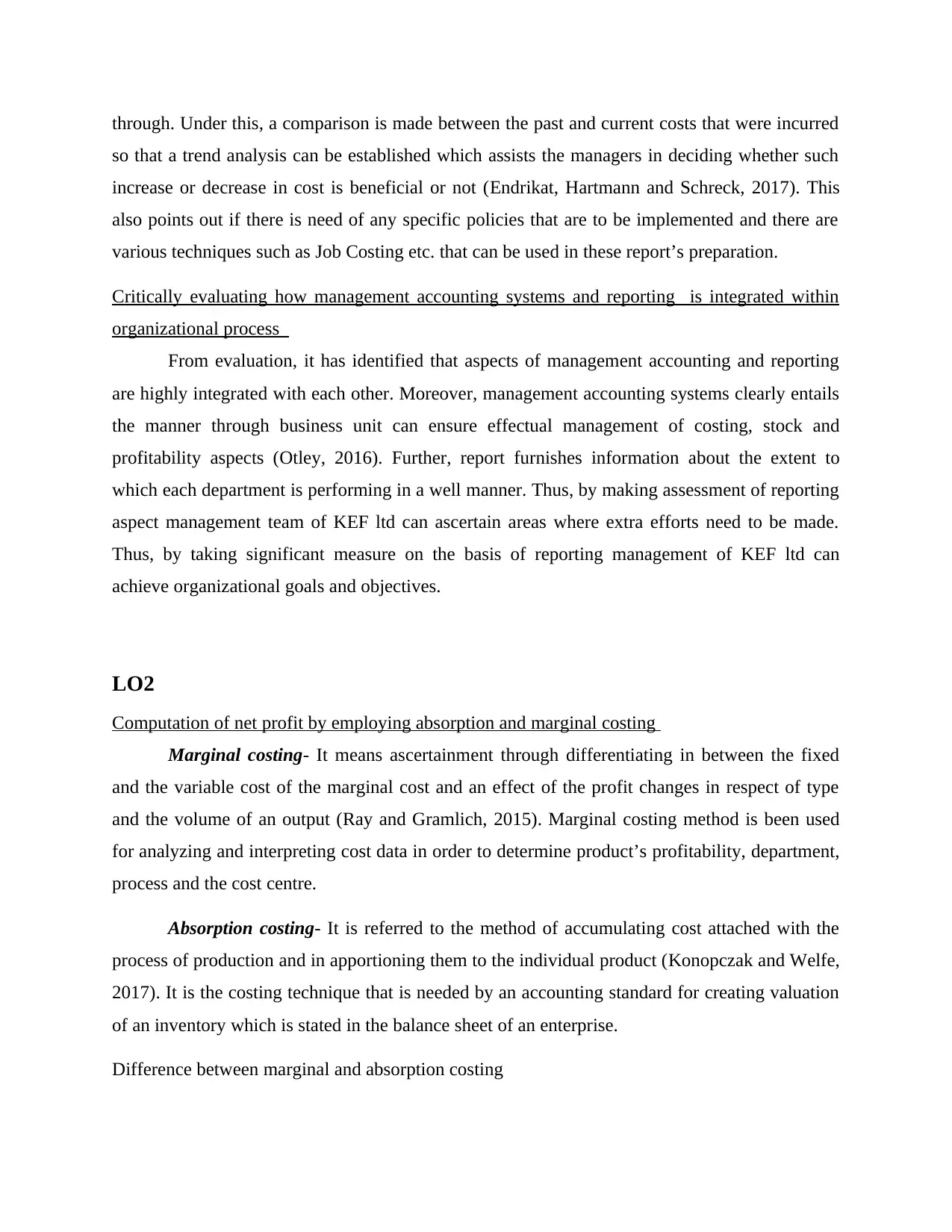
through. Under this, a comparison is made between the past and current costs that were incurred
so that a trend analysis can be established which assists the managers in deciding whether such
increase or decrease in cost is beneficial or not (Endrikat, Hartmann and Schreck, 2017). This
also points out if there is need of any specific policies that are to be implemented and there are
various techniques such as Job Costing etc. that can be used in these report’s preparation.
Critically evaluating how management accounting systems and reporting is integrated within
organizational process
From evaluation, it has identified that aspects of management accounting and reporting
are highly integrated with each other. Moreover, management accounting systems clearly entails
the manner through business unit can ensure effectual management of costing, stock and
profitability aspects (Otley, 2016). Further, report furnishes information about the extent to
which each department is performing in a well manner. Thus, by making assessment of reporting
aspect management team of KEF ltd can ascertain areas where extra efforts need to be made.
Thus, by taking significant measure on the basis of reporting management of KEF ltd can
achieve organizational goals and objectives.
LO2
Computation of net profit by employing absorption and marginal costing
Marginal costing- It means ascertainment through differentiating in between the fixed
and the variable cost of the marginal cost and an effect of the profit changes in respect of type
and the volume of an output (Ray and Gramlich, 2015). Marginal costing method is been used
for analyzing and interpreting cost data in order to determine product’s profitability, department,
process and the cost centre.
Absorption costing- It is referred to the method of accumulating cost attached with the
process of production and in apportioning them to the individual product (Konopczak and Welfe,
2017). It is the costing technique that is needed by an accounting standard for creating valuation
of an inventory which is stated in the balance sheet of an enterprise.
Difference between marginal and absorption costing
so that a trend analysis can be established which assists the managers in deciding whether such
increase or decrease in cost is beneficial or not (Endrikat, Hartmann and Schreck, 2017). This
also points out if there is need of any specific policies that are to be implemented and there are
various techniques such as Job Costing etc. that can be used in these report’s preparation.
Critically evaluating how management accounting systems and reporting is integrated within
organizational process
From evaluation, it has identified that aspects of management accounting and reporting
are highly integrated with each other. Moreover, management accounting systems clearly entails
the manner through business unit can ensure effectual management of costing, stock and
profitability aspects (Otley, 2016). Further, report furnishes information about the extent to
which each department is performing in a well manner. Thus, by making assessment of reporting
aspect management team of KEF ltd can ascertain areas where extra efforts need to be made.
Thus, by taking significant measure on the basis of reporting management of KEF ltd can
achieve organizational goals and objectives.
LO2
Computation of net profit by employing absorption and marginal costing
Marginal costing- It means ascertainment through differentiating in between the fixed
and the variable cost of the marginal cost and an effect of the profit changes in respect of type
and the volume of an output (Ray and Gramlich, 2015). Marginal costing method is been used
for analyzing and interpreting cost data in order to determine product’s profitability, department,
process and the cost centre.
Absorption costing- It is referred to the method of accumulating cost attached with the
process of production and in apportioning them to the individual product (Konopczak and Welfe,
2017). It is the costing technique that is needed by an accounting standard for creating valuation
of an inventory which is stated in the balance sheet of an enterprise.
Difference between marginal and absorption costing
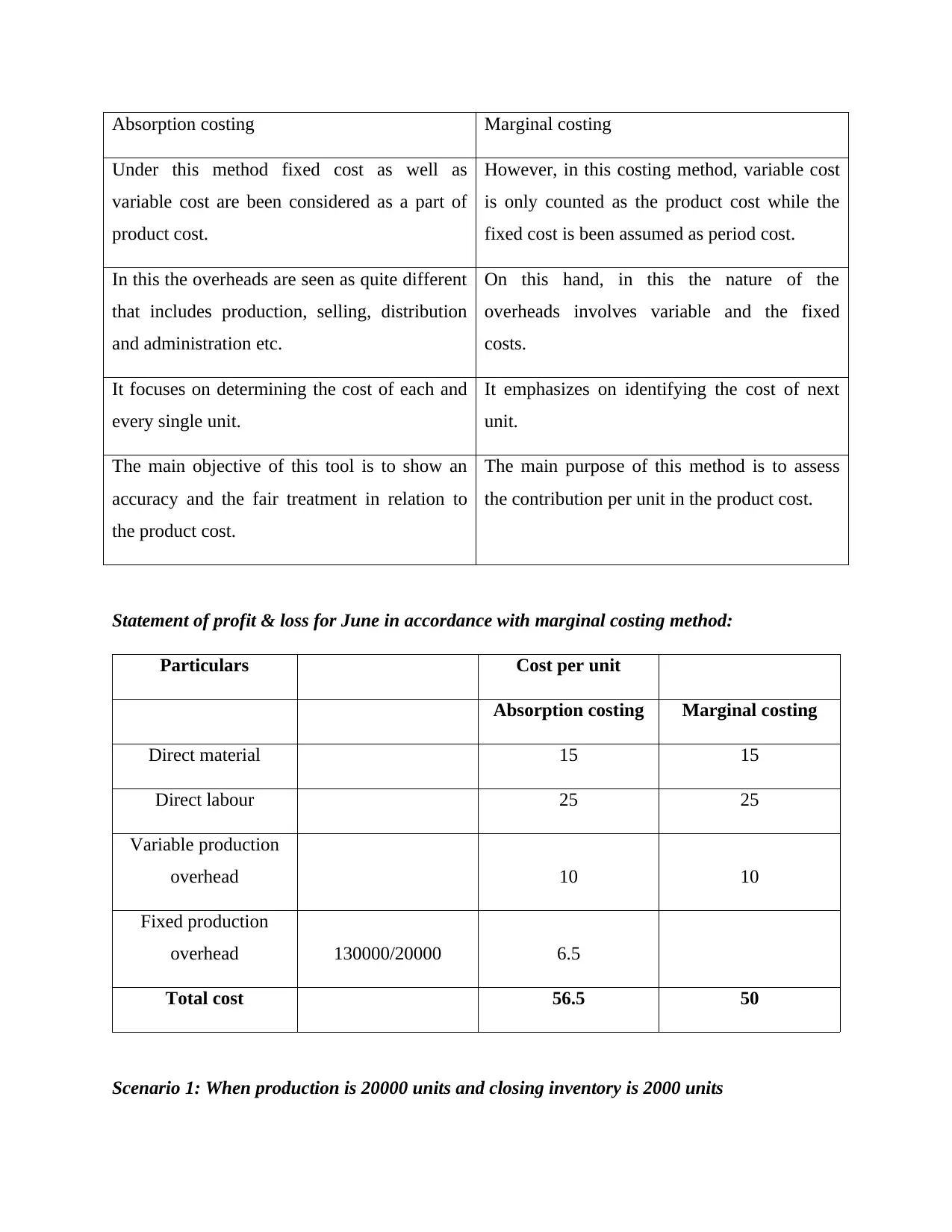
Absorption costing Marginal costing
Under this method fixed cost as well as
variable cost are been considered as a part of
product cost.
However, in this costing method, variable cost
is only counted as the product cost while the
fixed cost is been assumed as period cost.
In this the overheads are seen as quite different
that includes production, selling, distribution
and administration etc.
On this hand, in this the nature of the
overheads involves variable and the fixed
costs.
It focuses on determining the cost of each and
every single unit.
It emphasizes on identifying the cost of next
unit.
The main objective of this tool is to show an
accuracy and the fair treatment in relation to
the product cost.
The main purpose of this method is to assess
the contribution per unit in the product cost.
Statement of profit & loss for June in accordance with marginal costing method:
Particulars Cost per unit
Absorption costing Marginal costing
Direct material 15 15
Direct labour 25 25
Variable production
overhead 10 10
Fixed production
overhead 130000/20000 6.5
Total cost 56.5 50
Scenario 1: When production is 20000 units and closing inventory is 2000 units
Under this method fixed cost as well as
variable cost are been considered as a part of
product cost.
However, in this costing method, variable cost
is only counted as the product cost while the
fixed cost is been assumed as period cost.
In this the overheads are seen as quite different
that includes production, selling, distribution
and administration etc.
On this hand, in this the nature of the
overheads involves variable and the fixed
costs.
It focuses on determining the cost of each and
every single unit.
It emphasizes on identifying the cost of next
unit.
The main objective of this tool is to show an
accuracy and the fair treatment in relation to
the product cost.
The main purpose of this method is to assess
the contribution per unit in the product cost.
Statement of profit & loss for June in accordance with marginal costing method:
Particulars Cost per unit
Absorption costing Marginal costing
Direct material 15 15
Direct labour 25 25
Variable production
overhead 10 10
Fixed production
overhead 130000/20000 6.5
Total cost 56.5 50
Scenario 1: When production is 20000 units and closing inventory is 2000 units
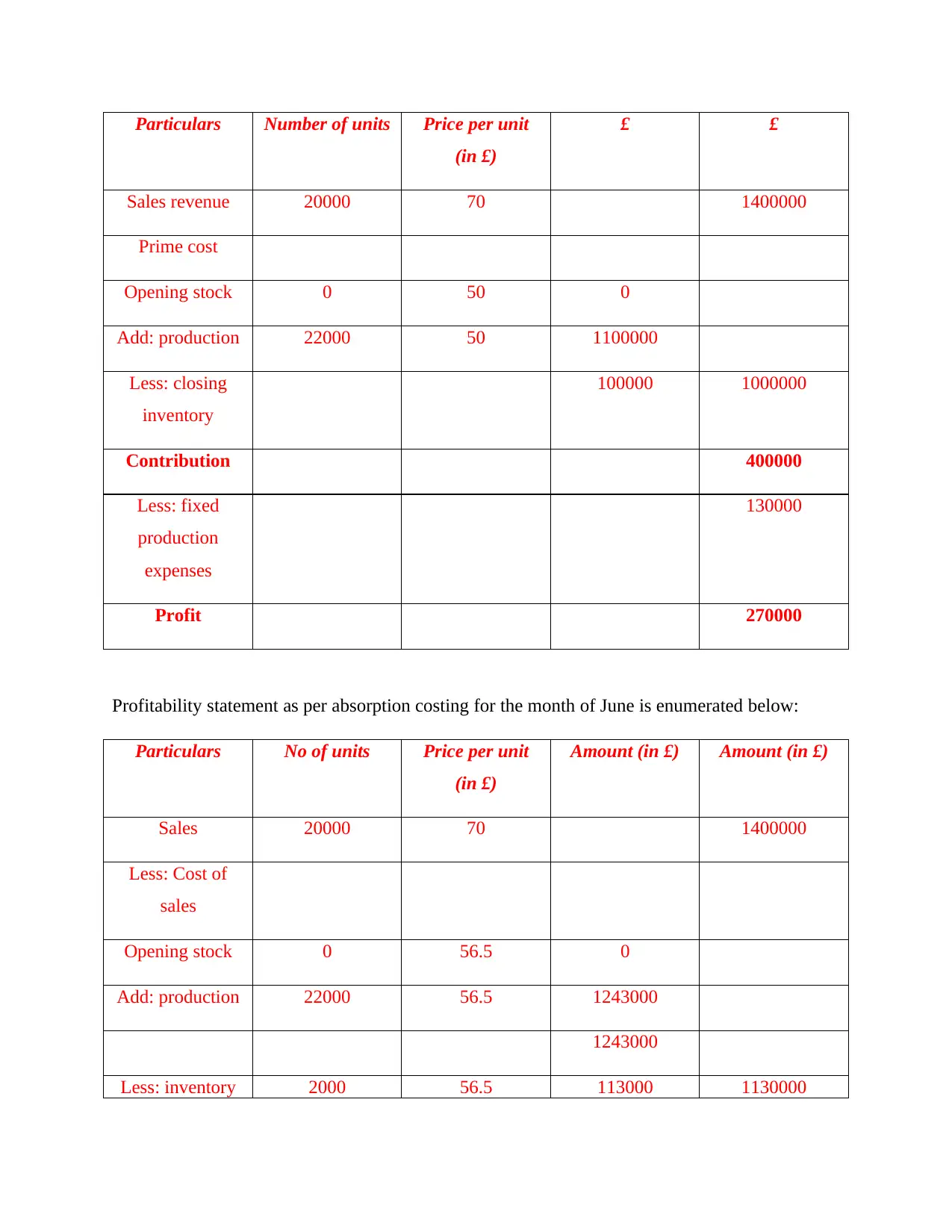
Particulars Number of units Price per unit
(in £)
£ £
Sales revenue 20000 70 1400000
Prime cost
Opening stock 0 50 0
Add: production 22000 50 1100000
Less: closing
inventory
100000 1000000
Contribution 400000
Less: fixed
production
expenses
130000
Profit 270000
Profitability statement as per absorption costing for the month of June is enumerated below:
Particulars No of units Price per unit
(in £)
Amount (in £) Amount (in £)
Sales 20000 70 1400000
Less: Cost of
sales
Opening stock 0 56.5 0
Add: production 22000 56.5 1243000
1243000
Less: inventory 2000 56.5 113000 1130000
(in £)
£ £
Sales revenue 20000 70 1400000
Prime cost
Opening stock 0 50 0
Add: production 22000 50 1100000
Less: closing
inventory
100000 1000000
Contribution 400000
Less: fixed
production
expenses
130000
Profit 270000
Profitability statement as per absorption costing for the month of June is enumerated below:
Particulars No of units Price per unit
(in £)
Amount (in £) Amount (in £)
Sales 20000 70 1400000
Less: Cost of
sales
Opening stock 0 56.5 0
Add: production 22000 56.5 1243000
1243000
Less: inventory 2000 56.5 113000 1130000
Secure Best Marks with AI Grader
Need help grading? Try our AI Grader for instant feedback on your assignments.
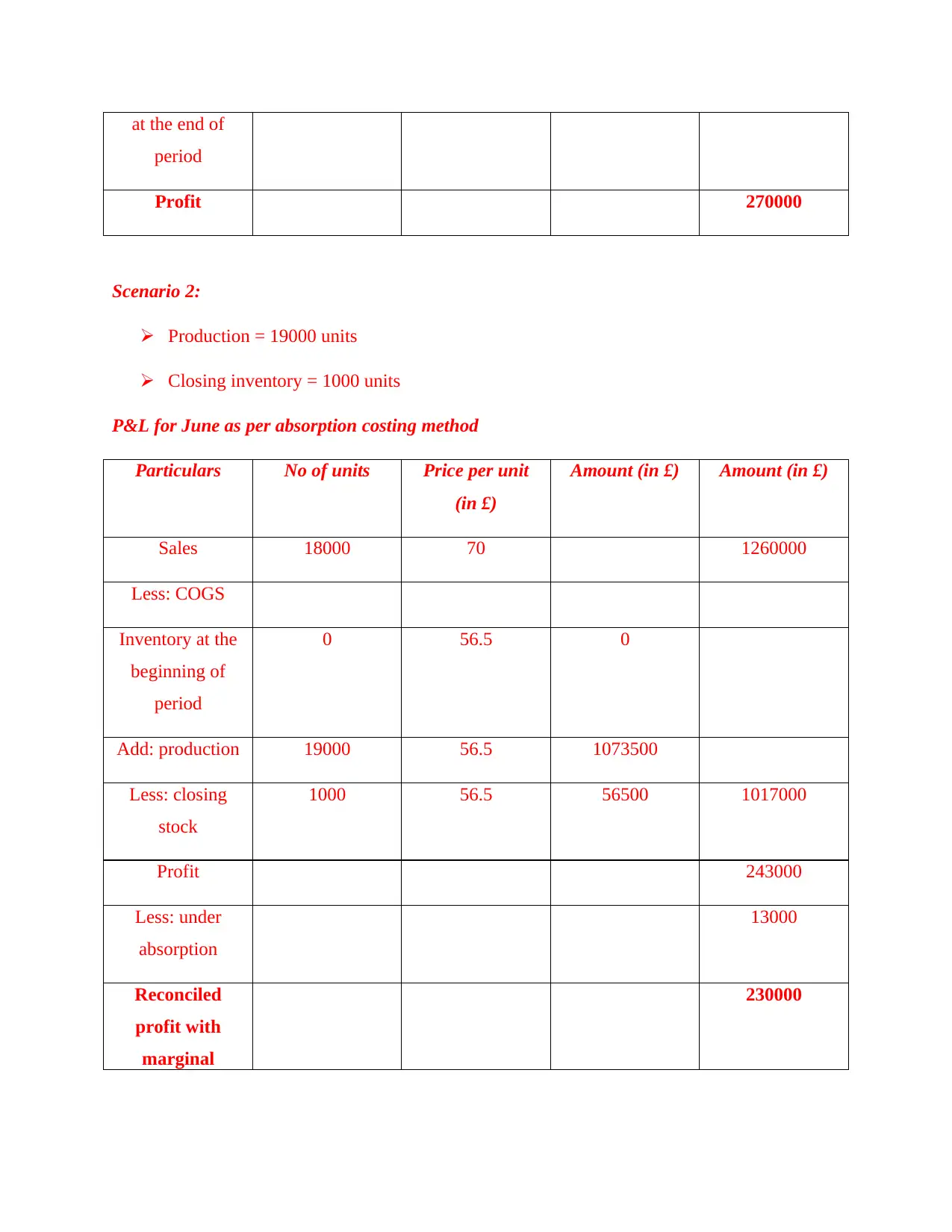
at the end of
period
Profit 270000
Scenario 2:
Production = 19000 units
Closing inventory = 1000 units
P&L for June as per absorption costing method
Particulars No of units Price per unit
(in £)
Amount (in £) Amount (in £)
Sales 18000 70 1260000
Less: COGS
Inventory at the
beginning of
period
0 56.5 0
Add: production 19000 56.5 1073500
Less: closing
stock
1000 56.5 56500 1017000
Profit 243000
Less: under
absorption
13000
Reconciled
profit with
marginal
230000
period
Profit 270000
Scenario 2:
Production = 19000 units
Closing inventory = 1000 units
P&L for June as per absorption costing method
Particulars No of units Price per unit
(in £)
Amount (in £) Amount (in £)
Sales 18000 70 1260000
Less: COGS
Inventory at the
beginning of
period
0 56.5 0
Add: production 19000 56.5 1073500
Less: closing
stock
1000 56.5 56500 1017000
Profit 243000
Less: under
absorption
13000
Reconciled
profit with
marginal
230000
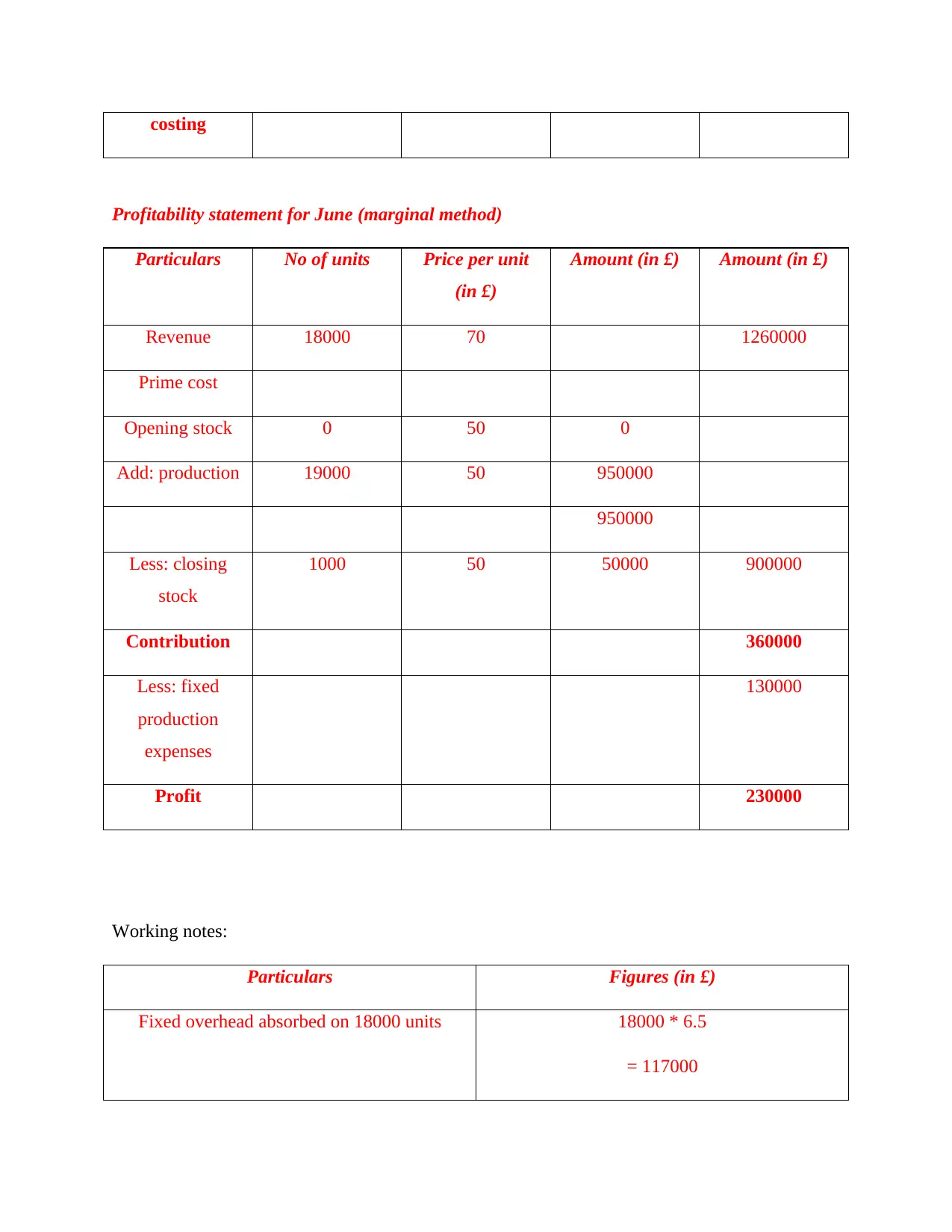
costing
Profitability statement for June (marginal method)
Particulars No of units Price per unit
(in £)
Amount (in £) Amount (in £)
Revenue 18000 70 1260000
Prime cost
Opening stock 0 50 0
Add: production 19000 50 950000
950000
Less: closing
stock
1000 50 50000 900000
Contribution 360000
Less: fixed
production
expenses
130000
Profit 230000
Working notes:
Particulars Figures (in £)
Fixed overhead absorbed on 18000 units 18000 * 6.5
= 117000
Profitability statement for June (marginal method)
Particulars No of units Price per unit
(in £)
Amount (in £) Amount (in £)
Revenue 18000 70 1260000
Prime cost
Opening stock 0 50 0
Add: production 19000 50 950000
950000
Less: closing
stock
1000 50 50000 900000
Contribution 360000
Less: fixed
production
expenses
130000
Profit 230000
Working notes:
Particulars Figures (in £)
Fixed overhead absorbed on 18000 units 18000 * 6.5
= 117000
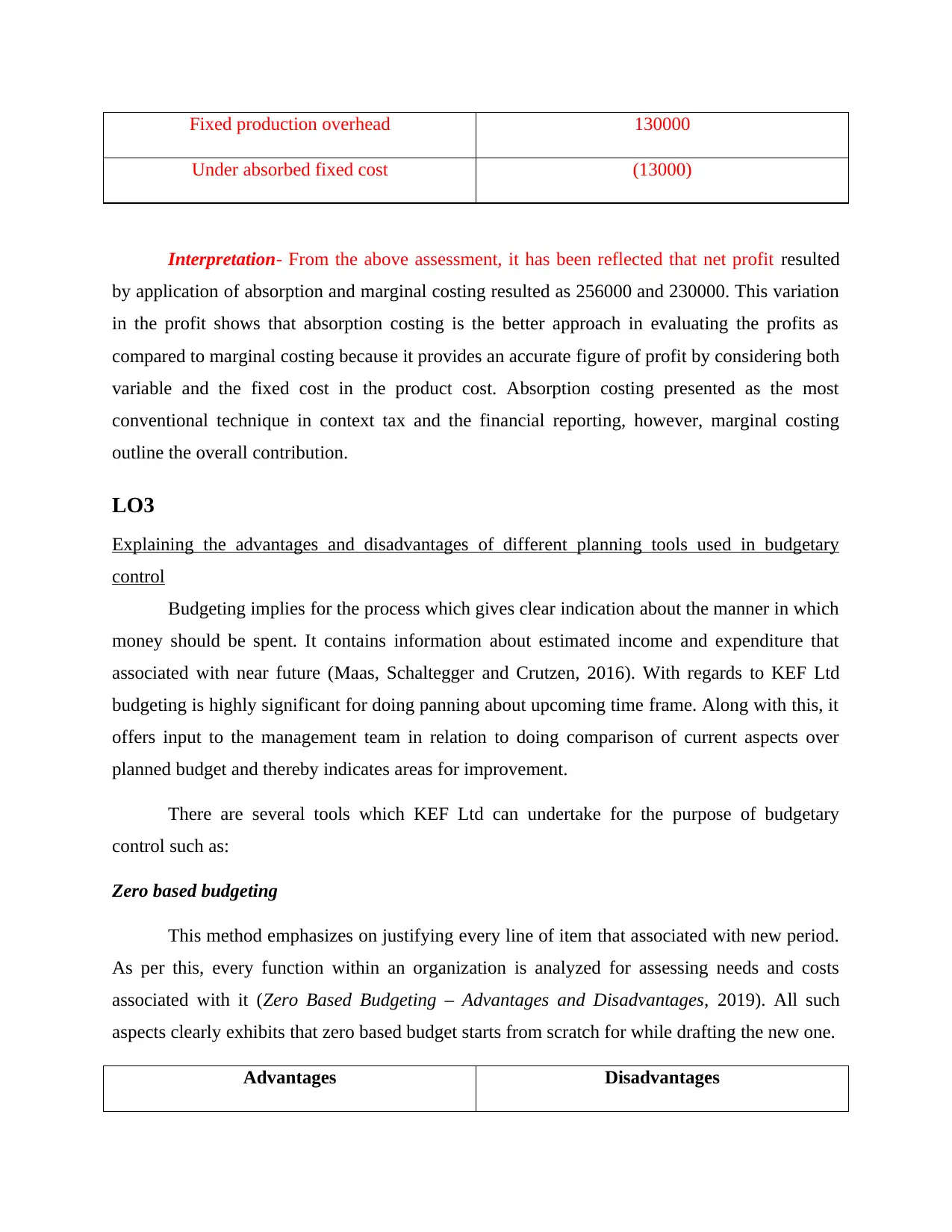
Fixed production overhead 130000
Under absorbed fixed cost (13000)
Interpretation- From the above assessment, it has been reflected that net profit resulted
by application of absorption and marginal costing resulted as 256000 and 230000. This variation
in the profit shows that absorption costing is the better approach in evaluating the profits as
compared to marginal costing because it provides an accurate figure of profit by considering both
variable and the fixed cost in the product cost. Absorption costing presented as the most
conventional technique in context tax and the financial reporting, however, marginal costing
outline the overall contribution.
LO3
Explaining the advantages and disadvantages of different planning tools used in budgetary
control
Budgeting implies for the process which gives clear indication about the manner in which
money should be spent. It contains information about estimated income and expenditure that
associated with near future (Maas, Schaltegger and Crutzen, 2016). With regards to KEF Ltd
budgeting is highly significant for doing panning about upcoming time frame. Along with this, it
offers input to the management team in relation to doing comparison of current aspects over
planned budget and thereby indicates areas for improvement.
There are several tools which KEF Ltd can undertake for the purpose of budgetary
control such as:
Zero based budgeting
This method emphasizes on justifying every line of item that associated with new period.
As per this, every function within an organization is analyzed for assessing needs and costs
associated with it (Zero Based Budgeting – Advantages and Disadvantages, 2019). All such
aspects clearly exhibits that zero based budget starts from scratch for while drafting the new one.
Advantages Disadvantages
Under absorbed fixed cost (13000)
Interpretation- From the above assessment, it has been reflected that net profit resulted
by application of absorption and marginal costing resulted as 256000 and 230000. This variation
in the profit shows that absorption costing is the better approach in evaluating the profits as
compared to marginal costing because it provides an accurate figure of profit by considering both
variable and the fixed cost in the product cost. Absorption costing presented as the most
conventional technique in context tax and the financial reporting, however, marginal costing
outline the overall contribution.
LO3
Explaining the advantages and disadvantages of different planning tools used in budgetary
control
Budgeting implies for the process which gives clear indication about the manner in which
money should be spent. It contains information about estimated income and expenditure that
associated with near future (Maas, Schaltegger and Crutzen, 2016). With regards to KEF Ltd
budgeting is highly significant for doing panning about upcoming time frame. Along with this, it
offers input to the management team in relation to doing comparison of current aspects over
planned budget and thereby indicates areas for improvement.
There are several tools which KEF Ltd can undertake for the purpose of budgetary
control such as:
Zero based budgeting
This method emphasizes on justifying every line of item that associated with new period.
As per this, every function within an organization is analyzed for assessing needs and costs
associated with it (Zero Based Budgeting – Advantages and Disadvantages, 2019). All such
aspects clearly exhibits that zero based budget starts from scratch for while drafting the new one.
Advantages Disadvantages
Paraphrase This Document
Need a fresh take? Get an instant paraphrase of this document with our AI Paraphraser

High orientation on cost-benefit
analysis
Ensures efficiency in resource
allocation
Facilitates reduction in redundant
activities
Subjective in nature
Detrimental to the long term goals
Skilled manpower requires for setting
budgets according to ZBB.
Operating budget
It refers to the forecasting of income and expenses pertaining to the future periods.
Usually, this budget is setting down by the management team in the beginning of period which in
turn shows expected activity level along with the estimated amount (Chenhall and Moers, 2015).
Advantages Disadvantages
Helps in managing current expenses
Assists in making projection about
future
Inclusion of federal tax implications
Time consuming exercise
Cash budget
It may be served as financial tool which includes estimated cash flows over a specific
time frame. This budgeting framework clearly presents whether business entity has enough cash
for future operations or not.
Advantages Disadvantages
Debt can be avoided by using cash
budgeting
Helps in assessing potential monetary
deficit quickly
Based on estimation rather than reality
Lack of flexibility aspects limit the
significance of cash budgeting
analysis
Ensures efficiency in resource
allocation
Facilitates reduction in redundant
activities
Subjective in nature
Detrimental to the long term goals
Skilled manpower requires for setting
budgets according to ZBB.
Operating budget
It refers to the forecasting of income and expenses pertaining to the future periods.
Usually, this budget is setting down by the management team in the beginning of period which in
turn shows expected activity level along with the estimated amount (Chenhall and Moers, 2015).
Advantages Disadvantages
Helps in managing current expenses
Assists in making projection about
future
Inclusion of federal tax implications
Time consuming exercise
Cash budget
It may be served as financial tool which includes estimated cash flows over a specific
time frame. This budgeting framework clearly presents whether business entity has enough cash
for future operations or not.
Advantages Disadvantages
Debt can be avoided by using cash
budgeting
Helps in assessing potential monetary
deficit quickly
Based on estimation rather than reality
Lack of flexibility aspects limit the
significance of cash budgeting
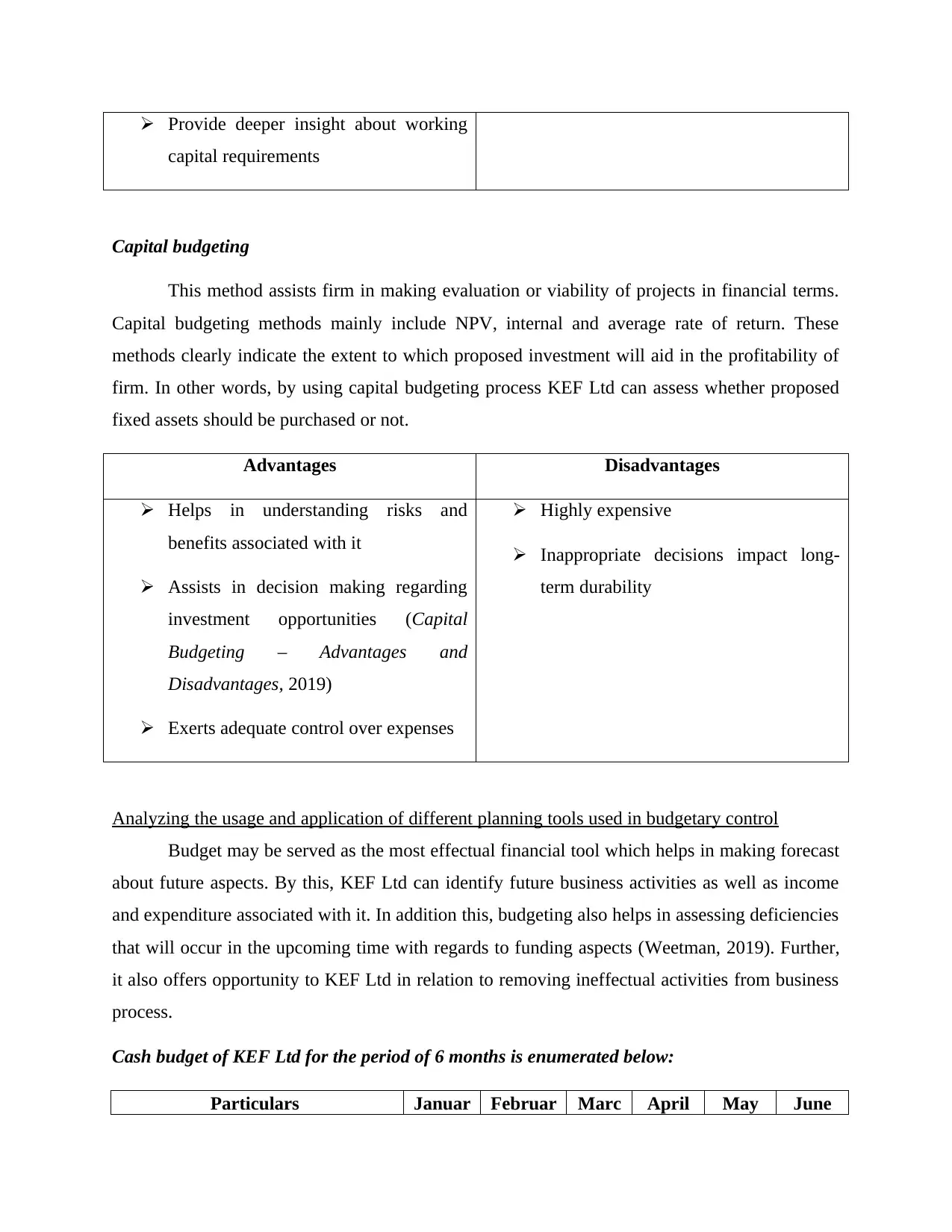
Provide deeper insight about working
capital requirements
Capital budgeting
This method assists firm in making evaluation or viability of projects in financial terms.
Capital budgeting methods mainly include NPV, internal and average rate of return. These
methods clearly indicate the extent to which proposed investment will aid in the profitability of
firm. In other words, by using capital budgeting process KEF Ltd can assess whether proposed
fixed assets should be purchased or not.
Advantages Disadvantages
Helps in understanding risks and
benefits associated with it
Assists in decision making regarding
investment opportunities (Capital
Budgeting – Advantages and
Disadvantages, 2019)
Exerts adequate control over expenses
Highly expensive
Inappropriate decisions impact long-
term durability
Analyzing the usage and application of different planning tools used in budgetary control
Budget may be served as the most effectual financial tool which helps in making forecast
about future aspects. By this, KEF Ltd can identify future business activities as well as income
and expenditure associated with it. In addition this, budgeting also helps in assessing deficiencies
that will occur in the upcoming time with regards to funding aspects (Weetman, 2019). Further,
it also offers opportunity to KEF Ltd in relation to removing ineffectual activities from business
process.
Cash budget of KEF Ltd for the period of 6 months is enumerated below:
Particulars Januar Februar Marc April May June
capital requirements
Capital budgeting
This method assists firm in making evaluation or viability of projects in financial terms.
Capital budgeting methods mainly include NPV, internal and average rate of return. These
methods clearly indicate the extent to which proposed investment will aid in the profitability of
firm. In other words, by using capital budgeting process KEF Ltd can assess whether proposed
fixed assets should be purchased or not.
Advantages Disadvantages
Helps in understanding risks and
benefits associated with it
Assists in decision making regarding
investment opportunities (Capital
Budgeting – Advantages and
Disadvantages, 2019)
Exerts adequate control over expenses
Highly expensive
Inappropriate decisions impact long-
term durability
Analyzing the usage and application of different planning tools used in budgetary control
Budget may be served as the most effectual financial tool which helps in making forecast
about future aspects. By this, KEF Ltd can identify future business activities as well as income
and expenditure associated with it. In addition this, budgeting also helps in assessing deficiencies
that will occur in the upcoming time with regards to funding aspects (Weetman, 2019). Further,
it also offers opportunity to KEF Ltd in relation to removing ineffectual activities from business
process.
Cash budget of KEF Ltd for the period of 6 months is enumerated below:
Particulars Januar Februar Marc April May June
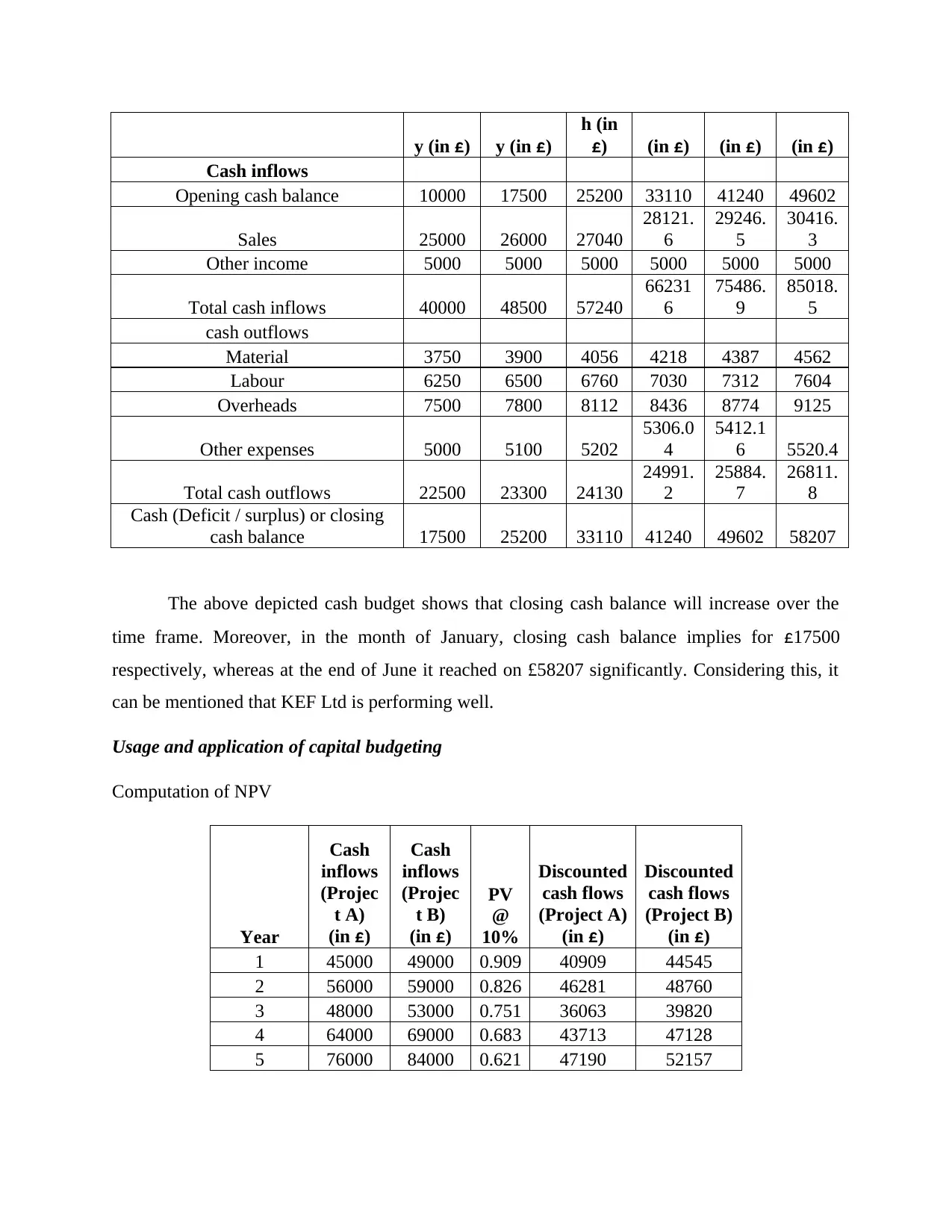
y (in £) y (in £)
h (in
£) (in £) (in £) (in £)
Cash inflows
Opening cash balance 10000 17500 25200 33110 41240 49602
Sales 25000 26000 27040
28121.
6
29246.
5
30416.
3
Other income 5000 5000 5000 5000 5000 5000
Total cash inflows 40000 48500 57240
66231
6
75486.
9
85018.
5
cash outflows
Material 3750 3900 4056 4218 4387 4562
Labour 6250 6500 6760 7030 7312 7604
Overheads 7500 7800 8112 8436 8774 9125
Other expenses 5000 5100 5202
5306.0
4
5412.1
6 5520.4
Total cash outflows 22500 23300 24130
24991.
2
25884.
7
26811.
8
Cash (Deficit / surplus) or closing
cash balance 17500 25200 33110 41240 49602 58207
The above depicted cash budget shows that closing cash balance will increase over the
time frame. Moreover, in the month of January, closing cash balance implies for £17500
respectively, whereas at the end of June it reached on £58207 significantly. Considering this, it
can be mentioned that KEF Ltd is performing well.
Usage and application of capital budgeting
Computation of NPV
Year
Cash
inflows
(Projec
t A)
(in £)
Cash
inflows
(Projec
t B)
(in £)
PV
@
10%
Discounted
cash flows
(Project A)
(in £)
Discounted
cash flows
(Project B)
(in £)
1 45000 49000 0.909 40909 44545
2 56000 59000 0.826 46281 48760
3 48000 53000 0.751 36063 39820
4 64000 69000 0.683 43713 47128
5 76000 84000 0.621 47190 52157
h (in
£) (in £) (in £) (in £)
Cash inflows
Opening cash balance 10000 17500 25200 33110 41240 49602
Sales 25000 26000 27040
28121.
6
29246.
5
30416.
3
Other income 5000 5000 5000 5000 5000 5000
Total cash inflows 40000 48500 57240
66231
6
75486.
9
85018.
5
cash outflows
Material 3750 3900 4056 4218 4387 4562
Labour 6250 6500 6760 7030 7312 7604
Overheads 7500 7800 8112 8436 8774 9125
Other expenses 5000 5100 5202
5306.0
4
5412.1
6 5520.4
Total cash outflows 22500 23300 24130
24991.
2
25884.
7
26811.
8
Cash (Deficit / surplus) or closing
cash balance 17500 25200 33110 41240 49602 58207
The above depicted cash budget shows that closing cash balance will increase over the
time frame. Moreover, in the month of January, closing cash balance implies for £17500
respectively, whereas at the end of June it reached on £58207 significantly. Considering this, it
can be mentioned that KEF Ltd is performing well.
Usage and application of capital budgeting
Computation of NPV
Year
Cash
inflows
(Projec
t A)
(in £)
Cash
inflows
(Projec
t B)
(in £)
PV
@
10%
Discounted
cash flows
(Project A)
(in £)
Discounted
cash flows
(Project B)
(in £)
1 45000 49000 0.909 40909 44545
2 56000 59000 0.826 46281 48760
3 48000 53000 0.751 36063 39820
4 64000 69000 0.683 43713 47128
5 76000 84000 0.621 47190 52157
Secure Best Marks with AI Grader
Need help grading? Try our AI Grader for instant feedback on your assignments.
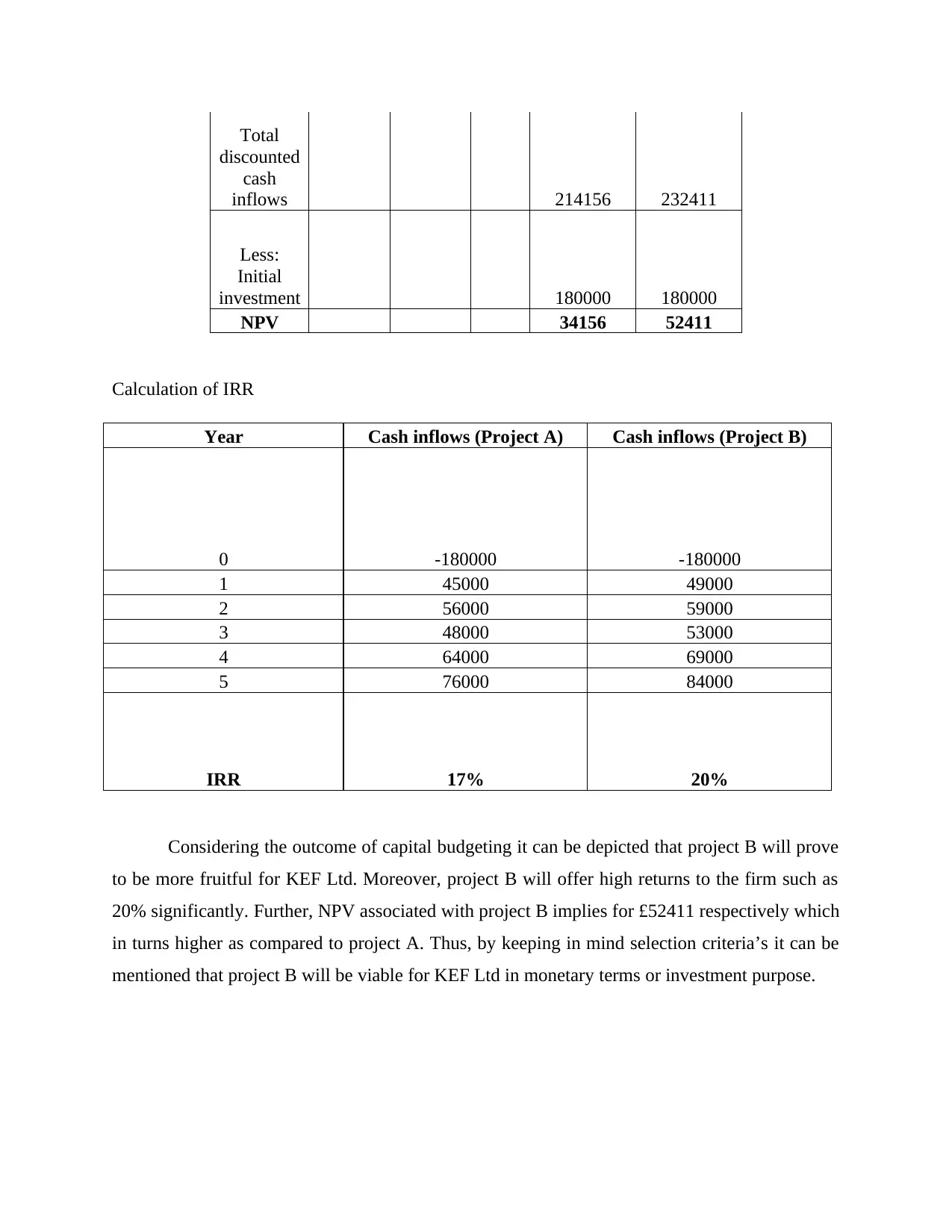
Total
discounted
cash
inflows 214156 232411
Less:
Initial
investment 180000 180000
NPV 34156 52411
Calculation of IRR
Year Cash inflows (Project A) Cash inflows (Project B)
0 -180000 -180000
1 45000 49000
2 56000 59000
3 48000 53000
4 64000 69000
5 76000 84000
IRR 17% 20%
Considering the outcome of capital budgeting it can be depicted that project B will prove
to be more fruitful for KEF Ltd. Moreover, project B will offer high returns to the firm such as
20% significantly. Further, NPV associated with project B implies for £52411 respectively which
in turns higher as compared to project A. Thus, by keeping in mind selection criteria’s it can be
mentioned that project B will be viable for KEF Ltd in monetary terms or investment purpose.
discounted
cash
inflows 214156 232411
Less:
Initial
investment 180000 180000
NPV 34156 52411
Calculation of IRR
Year Cash inflows (Project A) Cash inflows (Project B)
0 -180000 -180000
1 45000 49000
2 56000 59000
3 48000 53000
4 64000 69000
5 76000 84000
IRR 17% 20%
Considering the outcome of capital budgeting it can be depicted that project B will prove
to be more fruitful for KEF Ltd. Moreover, project B will offer high returns to the firm such as
20% significantly. Further, NPV associated with project B implies for £52411 respectively which
in turns higher as compared to project A. Thus, by keeping in mind selection criteria’s it can be
mentioned that project B will be viable for KEF Ltd in monetary terms or investment purpose.

LO4
Exhibits the manner in which financial problems can be responded
There are several tools that can be undertaken by the firm for deriving suitable solution of
financial problems. Moreover, in order to ensure smooth functioning of business operations and
function company is required to take appropriate measure or tool within the suitable time frame.
Balance scorecard:
This is one of the most effectual tools which helps company in resolving both monetary
and non-monetary issues effectually. Moreover, it emphasizes on measuring performance from
several perspectives including financial, customer, internal process and organizational capacity
(Cooper, Ezzamel and Qu, 2017). Thus, by making evaluation of performance in against to such
four aspects KEF Ltd can assess areas where improvements are required and drives overall
business performance.
Advantages Disadvantages
Clearly indicates company’s
performance and areas for improvement
Helps in setting appropriate goals in
line with company’s vision and
mission
Highly time consuming
Expensive in nature
Financial governance:
It implies for the ways in which organization gathers, manages, monitors and control
monetary information. In other words, by using this technique management team can assess the
manner in which business unit is tracking monetary and other aspects. Besides this, compliance
with disclosure aspects can also be monitored using financial governance tool (Malmi, 2016).
Hence, with the help of financial governance tool KEF Ltd can identify loopholes in the existing
operational aspect and thereby takes measure for improvement.
Advantages Disadvantages
Exhibits the manner in which financial problems can be responded
There are several tools that can be undertaken by the firm for deriving suitable solution of
financial problems. Moreover, in order to ensure smooth functioning of business operations and
function company is required to take appropriate measure or tool within the suitable time frame.
Balance scorecard:
This is one of the most effectual tools which helps company in resolving both monetary
and non-monetary issues effectually. Moreover, it emphasizes on measuring performance from
several perspectives including financial, customer, internal process and organizational capacity
(Cooper, Ezzamel and Qu, 2017). Thus, by making evaluation of performance in against to such
four aspects KEF Ltd can assess areas where improvements are required and drives overall
business performance.
Advantages Disadvantages
Clearly indicates company’s
performance and areas for improvement
Helps in setting appropriate goals in
line with company’s vision and
mission
Highly time consuming
Expensive in nature
Financial governance:
It implies for the ways in which organization gathers, manages, monitors and control
monetary information. In other words, by using this technique management team can assess the
manner in which business unit is tracking monetary and other aspects. Besides this, compliance
with disclosure aspects can also be monitored using financial governance tool (Malmi, 2016).
Hence, with the help of financial governance tool KEF Ltd can identify loopholes in the existing
operational aspect and thereby takes measure for improvement.
Advantages Disadvantages
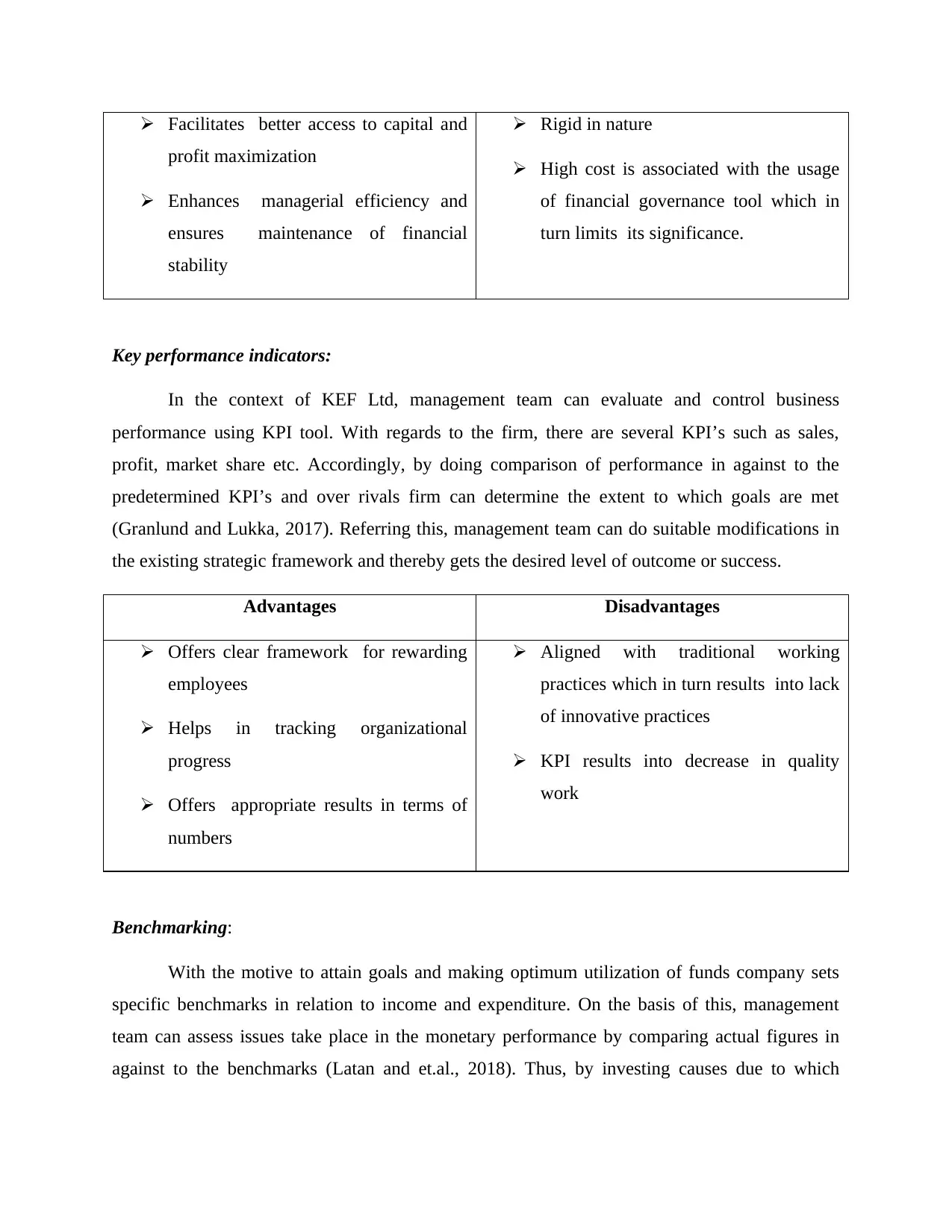
Facilitates better access to capital and
profit maximization
Enhances managerial efficiency and
ensures maintenance of financial
stability
Rigid in nature
High cost is associated with the usage
of financial governance tool which in
turn limits its significance.
Key performance indicators:
In the context of KEF Ltd, management team can evaluate and control business
performance using KPI tool. With regards to the firm, there are several KPI’s such as sales,
profit, market share etc. Accordingly, by doing comparison of performance in against to the
predetermined KPI’s and over rivals firm can determine the extent to which goals are met
(Granlund and Lukka, 2017). Referring this, management team can do suitable modifications in
the existing strategic framework and thereby gets the desired level of outcome or success.
Advantages Disadvantages
Offers clear framework for rewarding
employees
Helps in tracking organizational
progress
Offers appropriate results in terms of
numbers
Aligned with traditional working
practices which in turn results into lack
of innovative practices
KPI results into decrease in quality
work
Benchmarking:
With the motive to attain goals and making optimum utilization of funds company sets
specific benchmarks in relation to income and expenditure. On the basis of this, management
team can assess issues take place in the monetary performance by comparing actual figures in
against to the benchmarks (Latan and et.al., 2018). Thus, by investing causes due to which
profit maximization
Enhances managerial efficiency and
ensures maintenance of financial
stability
Rigid in nature
High cost is associated with the usage
of financial governance tool which in
turn limits its significance.
Key performance indicators:
In the context of KEF Ltd, management team can evaluate and control business
performance using KPI tool. With regards to the firm, there are several KPI’s such as sales,
profit, market share etc. Accordingly, by doing comparison of performance in against to the
predetermined KPI’s and over rivals firm can determine the extent to which goals are met
(Granlund and Lukka, 2017). Referring this, management team can do suitable modifications in
the existing strategic framework and thereby gets the desired level of outcome or success.
Advantages Disadvantages
Offers clear framework for rewarding
employees
Helps in tracking organizational
progress
Offers appropriate results in terms of
numbers
Aligned with traditional working
practices which in turn results into lack
of innovative practices
KPI results into decrease in quality
work
Benchmarking:
With the motive to attain goals and making optimum utilization of funds company sets
specific benchmarks in relation to income and expenditure. On the basis of this, management
team can assess issues take place in the monetary performance by comparing actual figures in
against to the benchmarks (Latan and et.al., 2018). Thus, by investing causes due to which
Paraphrase This Document
Need a fresh take? Get an instant paraphrase of this document with our AI Paraphraser
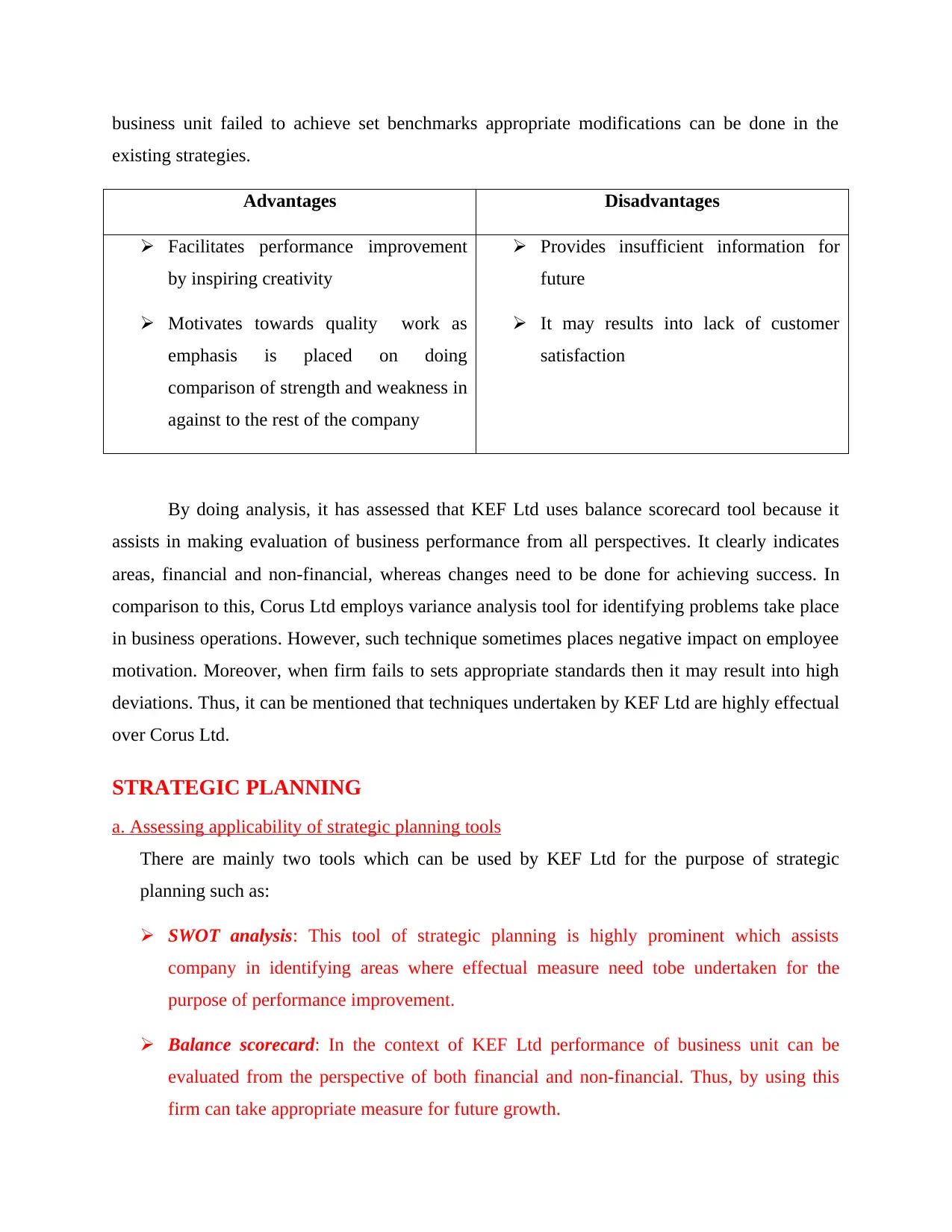
business unit failed to achieve set benchmarks appropriate modifications can be done in the
existing strategies.
Advantages Disadvantages
Facilitates performance improvement
by inspiring creativity
Motivates towards quality work as
emphasis is placed on doing
comparison of strength and weakness in
against to the rest of the company
Provides insufficient information for
future
It may results into lack of customer
satisfaction
By doing analysis, it has assessed that KEF Ltd uses balance scorecard tool because it
assists in making evaluation of business performance from all perspectives. It clearly indicates
areas, financial and non-financial, whereas changes need to be done for achieving success. In
comparison to this, Corus Ltd employs variance analysis tool for identifying problems take place
in business operations. However, such technique sometimes places negative impact on employee
motivation. Moreover, when firm fails to sets appropriate standards then it may result into high
deviations. Thus, it can be mentioned that techniques undertaken by KEF Ltd are highly effectual
over Corus Ltd.
STRATEGIC PLANNING
a. Assessing applicability of strategic planning tools
There are mainly two tools which can be used by KEF Ltd for the purpose of strategic
planning such as:
SWOT analysis: This tool of strategic planning is highly prominent which assists
company in identifying areas where effectual measure need tobe undertaken for the
purpose of performance improvement.
Balance scorecard: In the context of KEF Ltd performance of business unit can be
evaluated from the perspective of both financial and non-financial. Thus, by using this
firm can take appropriate measure for future growth.
existing strategies.
Advantages Disadvantages
Facilitates performance improvement
by inspiring creativity
Motivates towards quality work as
emphasis is placed on doing
comparison of strength and weakness in
against to the rest of the company
Provides insufficient information for
future
It may results into lack of customer
satisfaction
By doing analysis, it has assessed that KEF Ltd uses balance scorecard tool because it
assists in making evaluation of business performance from all perspectives. It clearly indicates
areas, financial and non-financial, whereas changes need to be done for achieving success. In
comparison to this, Corus Ltd employs variance analysis tool for identifying problems take place
in business operations. However, such technique sometimes places negative impact on employee
motivation. Moreover, when firm fails to sets appropriate standards then it may result into high
deviations. Thus, it can be mentioned that techniques undertaken by KEF Ltd are highly effectual
over Corus Ltd.
STRATEGIC PLANNING
a. Assessing applicability of strategic planning tools
There are mainly two tools which can be used by KEF Ltd for the purpose of strategic
planning such as:
SWOT analysis: This tool of strategic planning is highly prominent which assists
company in identifying areas where effectual measure need tobe undertaken for the
purpose of performance improvement.
Balance scorecard: In the context of KEF Ltd performance of business unit can be
evaluated from the perspective of both financial and non-financial. Thus, by using this
firm can take appropriate measure for future growth.
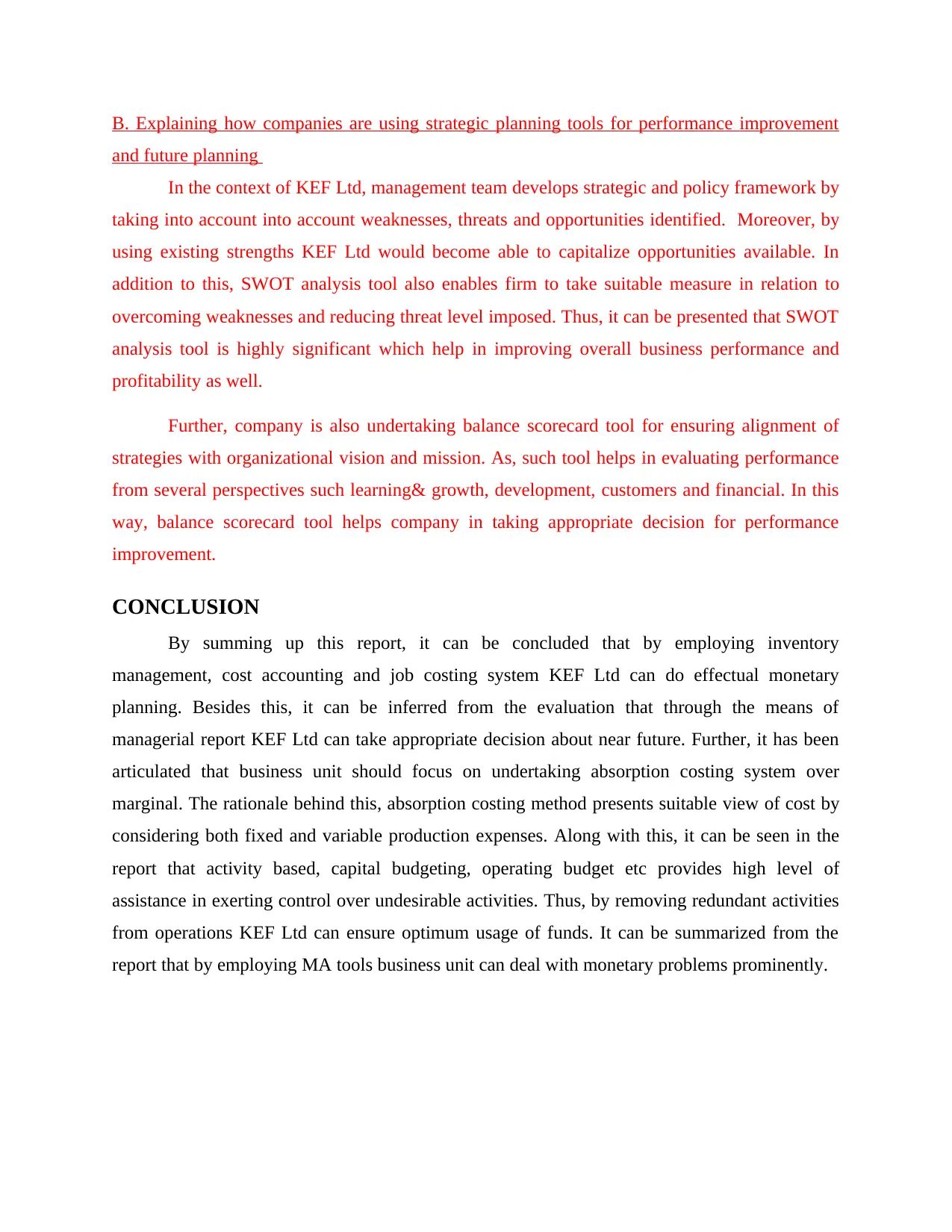
B. Explaining how companies are using strategic planning tools for performance improvement
and future planning
In the context of KEF Ltd, management team develops strategic and policy framework by
taking into account into account weaknesses, threats and opportunities identified. Moreover, by
using existing strengths KEF Ltd would become able to capitalize opportunities available. In
addition to this, SWOT analysis tool also enables firm to take suitable measure in relation to
overcoming weaknesses and reducing threat level imposed. Thus, it can be presented that SWOT
analysis tool is highly significant which help in improving overall business performance and
profitability as well.
Further, company is also undertaking balance scorecard tool for ensuring alignment of
strategies with organizational vision and mission. As, such tool helps in evaluating performance
from several perspectives such learning& growth, development, customers and financial. In this
way, balance scorecard tool helps company in taking appropriate decision for performance
improvement.
CONCLUSION
By summing up this report, it can be concluded that by employing inventory
management, cost accounting and job costing system KEF Ltd can do effectual monetary
planning. Besides this, it can be inferred from the evaluation that through the means of
managerial report KEF Ltd can take appropriate decision about near future. Further, it has been
articulated that business unit should focus on undertaking absorption costing system over
marginal. The rationale behind this, absorption costing method presents suitable view of cost by
considering both fixed and variable production expenses. Along with this, it can be seen in the
report that activity based, capital budgeting, operating budget etc provides high level of
assistance in exerting control over undesirable activities. Thus, by removing redundant activities
from operations KEF Ltd can ensure optimum usage of funds. It can be summarized from the
report that by employing MA tools business unit can deal with monetary problems prominently.
and future planning
In the context of KEF Ltd, management team develops strategic and policy framework by
taking into account into account weaknesses, threats and opportunities identified. Moreover, by
using existing strengths KEF Ltd would become able to capitalize opportunities available. In
addition to this, SWOT analysis tool also enables firm to take suitable measure in relation to
overcoming weaknesses and reducing threat level imposed. Thus, it can be presented that SWOT
analysis tool is highly significant which help in improving overall business performance and
profitability as well.
Further, company is also undertaking balance scorecard tool for ensuring alignment of
strategies with organizational vision and mission. As, such tool helps in evaluating performance
from several perspectives such learning& growth, development, customers and financial. In this
way, balance scorecard tool helps company in taking appropriate decision for performance
improvement.
CONCLUSION
By summing up this report, it can be concluded that by employing inventory
management, cost accounting and job costing system KEF Ltd can do effectual monetary
planning. Besides this, it can be inferred from the evaluation that through the means of
managerial report KEF Ltd can take appropriate decision about near future. Further, it has been
articulated that business unit should focus on undertaking absorption costing system over
marginal. The rationale behind this, absorption costing method presents suitable view of cost by
considering both fixed and variable production expenses. Along with this, it can be seen in the
report that activity based, capital budgeting, operating budget etc provides high level of
assistance in exerting control over undesirable activities. Thus, by removing redundant activities
from operations KEF Ltd can ensure optimum usage of funds. It can be summarized from the
report that by employing MA tools business unit can deal with monetary problems prominently.

REFERENCES
Books and Journals
Agrawal, A. and Cooper, T., 2017. Corporate governance consequences of accounting scandals:
Evidence from top management, CFO and auditor turnover. Quarterly Journal of
Finance. 7(01). p.1650014.
Chenhall, R. H. and Moers, F., 2015. The role of innovation in the evolution of management
accounting and its integration into management control. Accounting, organizations and
society. 47. pp.1-13.
Cooper, D. J., Ezzamel, M. and Qu, S. Q., 2017. Popularizing a management accounting idea:
The case of the balanced scorecard. Contemporary Accounting Research. 34(2). pp.991-1025.
Eldenburg, L.G., Krishnan, H.A. and Krishnan, R., 2017. Management accounting and control in
the hospital industry: A review. Journal of Governmental & Nonprofit Accounting. 6(1).
pp.52-91
Endrikat, J., Hartmann, F. and Schreck, P., 2017. Social and ethical issues in management
accounting and control: an editorial.
Granlund, M. and Lukka, K., 2017. Investigating highly established research paradigms:
Reviving contextuality in contingency theory based management accounting
research. Critical Perspectives on Accounting. 45. pp.63-80.
Konopczak, K. and Welfe, A., 2017. Convergence-driven inflation and the channels of its
absorption. Journal of Policy Modeling. 39(6). pp.1019-1034.
Latan, H. and et.al., 2018. Effects of environmental strategy, environmental uncertainty and top
management's commitment on corporate environmental performance: The role of
environmental management accounting. Journal of cleaner production. 180. pp.297-306.
Lopez-Valeiras, E., Gomez-Conde, J. and Naranjo-Gil, D., 2015. Sustainable innovation,
management accounting and control systems, and international performance.
Sustainability. 7(3). pp.3479-3492.
Books and Journals
Agrawal, A. and Cooper, T., 2017. Corporate governance consequences of accounting scandals:
Evidence from top management, CFO and auditor turnover. Quarterly Journal of
Finance. 7(01). p.1650014.
Chenhall, R. H. and Moers, F., 2015. The role of innovation in the evolution of management
accounting and its integration into management control. Accounting, organizations and
society. 47. pp.1-13.
Cooper, D. J., Ezzamel, M. and Qu, S. Q., 2017. Popularizing a management accounting idea:
The case of the balanced scorecard. Contemporary Accounting Research. 34(2). pp.991-1025.
Eldenburg, L.G., Krishnan, H.A. and Krishnan, R., 2017. Management accounting and control in
the hospital industry: A review. Journal of Governmental & Nonprofit Accounting. 6(1).
pp.52-91
Endrikat, J., Hartmann, F. and Schreck, P., 2017. Social and ethical issues in management
accounting and control: an editorial.
Granlund, M. and Lukka, K., 2017. Investigating highly established research paradigms:
Reviving contextuality in contingency theory based management accounting
research. Critical Perspectives on Accounting. 45. pp.63-80.
Konopczak, K. and Welfe, A., 2017. Convergence-driven inflation and the channels of its
absorption. Journal of Policy Modeling. 39(6). pp.1019-1034.
Latan, H. and et.al., 2018. Effects of environmental strategy, environmental uncertainty and top
management's commitment on corporate environmental performance: The role of
environmental management accounting. Journal of cleaner production. 180. pp.297-306.
Lopez-Valeiras, E., Gomez-Conde, J. and Naranjo-Gil, D., 2015. Sustainable innovation,
management accounting and control systems, and international performance.
Sustainability. 7(3). pp.3479-3492.
Secure Best Marks with AI Grader
Need help grading? Try our AI Grader for instant feedback on your assignments.
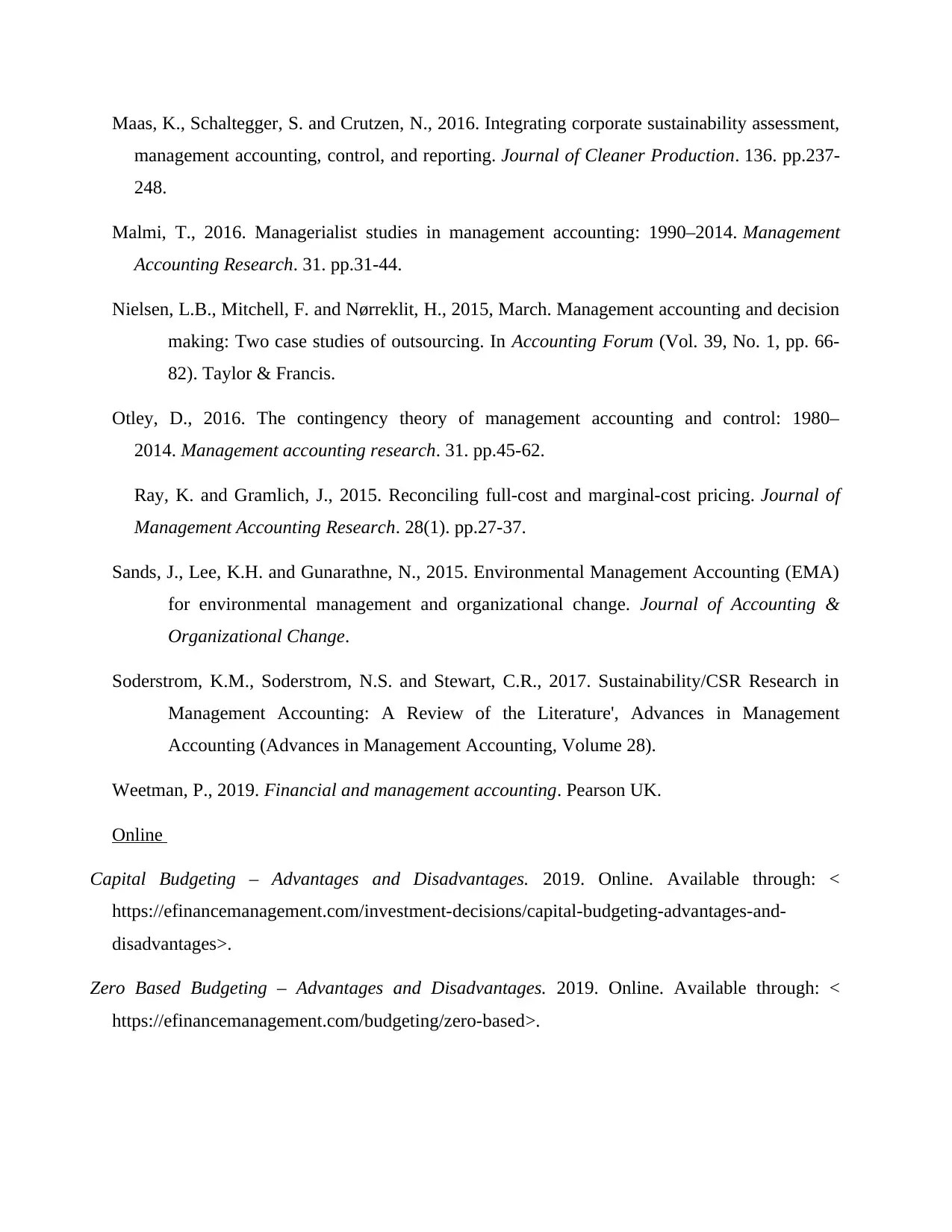
Maas, K., Schaltegger, S. and Crutzen, N., 2016. Integrating corporate sustainability assessment,
management accounting, control, and reporting. Journal of Cleaner Production. 136. pp.237-
248.
Malmi, T., 2016. Managerialist studies in management accounting: 1990–2014. Management
Accounting Research. 31. pp.31-44.
Nielsen, L.B., Mitchell, F. and Nørreklit, H., 2015, March. Management accounting and decision
making: Two case studies of outsourcing. In Accounting Forum (Vol. 39, No. 1, pp. 66-
82). Taylor & Francis.
Otley, D., 2016. The contingency theory of management accounting and control: 1980–
2014. Management accounting research. 31. pp.45-62.
Ray, K. and Gramlich, J., 2015. Reconciling full-cost and marginal-cost pricing. Journal of
Management Accounting Research. 28(1). pp.27-37.
Sands, J., Lee, K.H. and Gunarathne, N., 2015. Environmental Management Accounting (EMA)
for environmental management and organizational change. Journal of Accounting &
Organizational Change.
Soderstrom, K.M., Soderstrom, N.S. and Stewart, C.R., 2017. Sustainability/CSR Research in
Management Accounting: A Review of the Literature', Advances in Management
Accounting (Advances in Management Accounting, Volume 28).
Weetman, P., 2019. Financial and management accounting. Pearson UK.
Online
Capital Budgeting – Advantages and Disadvantages. 2019. Online. Available through: <
https://efinancemanagement.com/investment-decisions/capital-budgeting-advantages-and-
disadvantages>.
Zero Based Budgeting – Advantages and Disadvantages. 2019. Online. Available through: <
https://efinancemanagement.com/budgeting/zero-based>.
management accounting, control, and reporting. Journal of Cleaner Production. 136. pp.237-
248.
Malmi, T., 2016. Managerialist studies in management accounting: 1990–2014. Management
Accounting Research. 31. pp.31-44.
Nielsen, L.B., Mitchell, F. and Nørreklit, H., 2015, March. Management accounting and decision
making: Two case studies of outsourcing. In Accounting Forum (Vol. 39, No. 1, pp. 66-
82). Taylor & Francis.
Otley, D., 2016. The contingency theory of management accounting and control: 1980–
2014. Management accounting research. 31. pp.45-62.
Ray, K. and Gramlich, J., 2015. Reconciling full-cost and marginal-cost pricing. Journal of
Management Accounting Research. 28(1). pp.27-37.
Sands, J., Lee, K.H. and Gunarathne, N., 2015. Environmental Management Accounting (EMA)
for environmental management and organizational change. Journal of Accounting &
Organizational Change.
Soderstrom, K.M., Soderstrom, N.S. and Stewart, C.R., 2017. Sustainability/CSR Research in
Management Accounting: A Review of the Literature', Advances in Management
Accounting (Advances in Management Accounting, Volume 28).
Weetman, P., 2019. Financial and management accounting. Pearson UK.
Online
Capital Budgeting – Advantages and Disadvantages. 2019. Online. Available through: <
https://efinancemanagement.com/investment-decisions/capital-budgeting-advantages-and-
disadvantages>.
Zero Based Budgeting – Advantages and Disadvantages. 2019. Online. Available through: <
https://efinancemanagement.com/budgeting/zero-based>.
1 out of 23
Related Documents
Your All-in-One AI-Powered Toolkit for Academic Success.
+13062052269
info@desklib.com
Available 24*7 on WhatsApp / Email
![[object Object]](/_next/static/media/star-bottom.7253800d.svg)
Unlock your academic potential
© 2024 | Zucol Services PVT LTD | All rights reserved.





